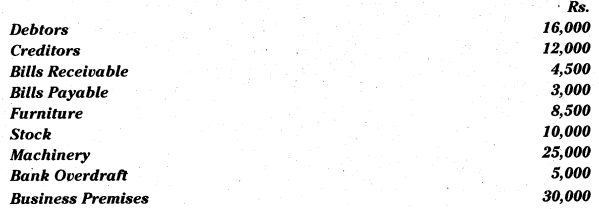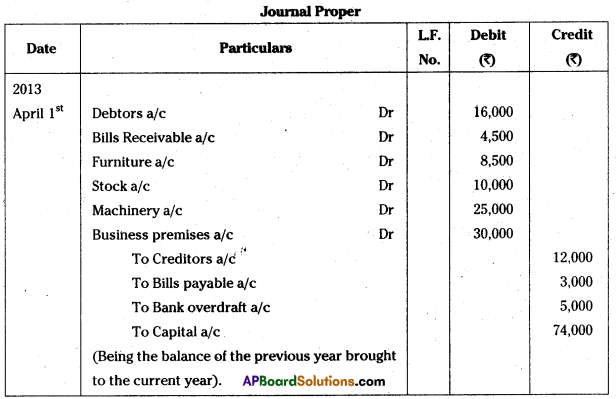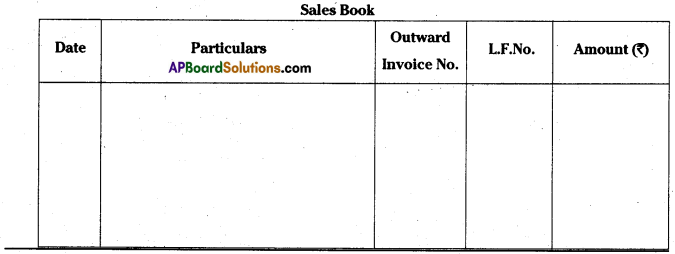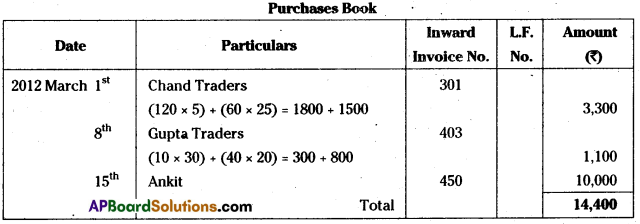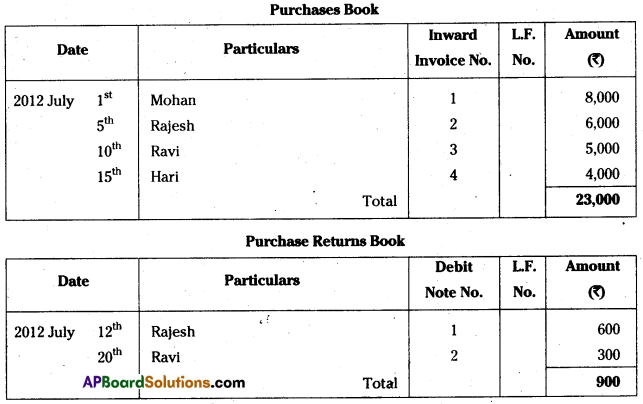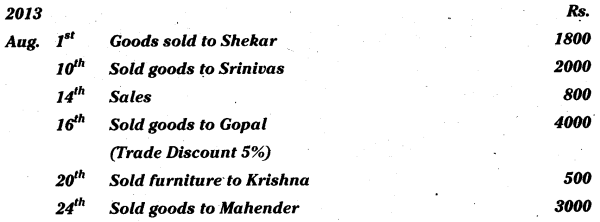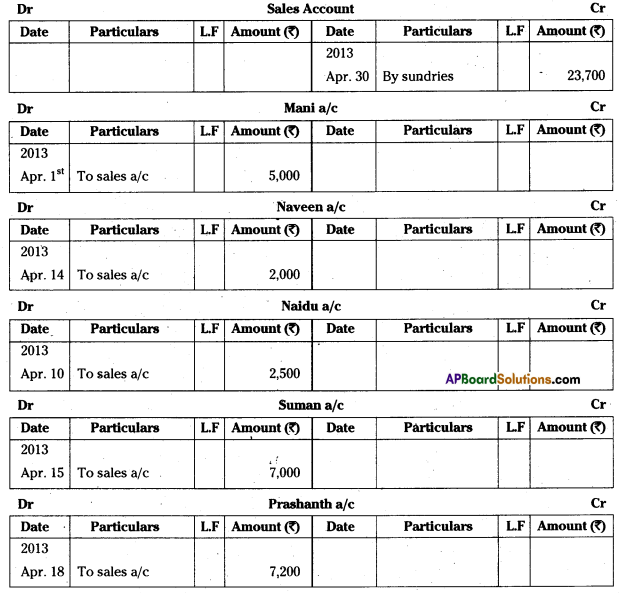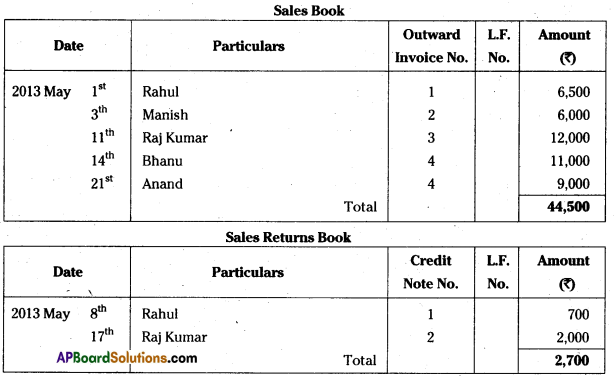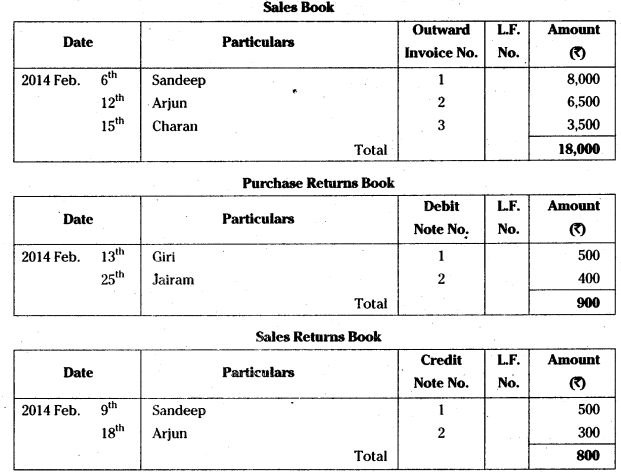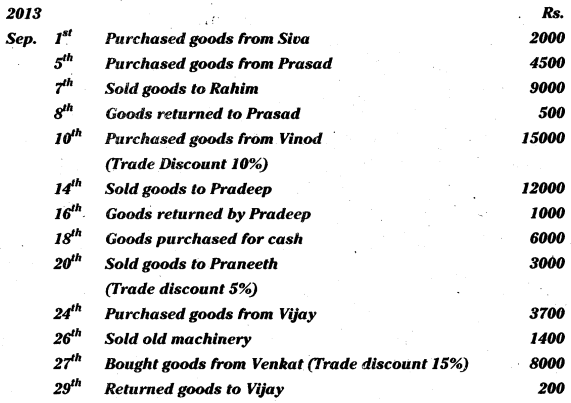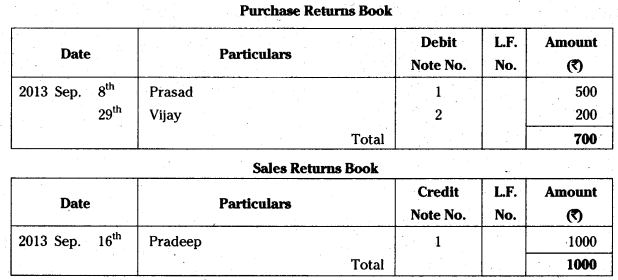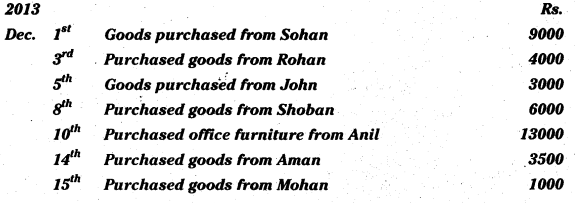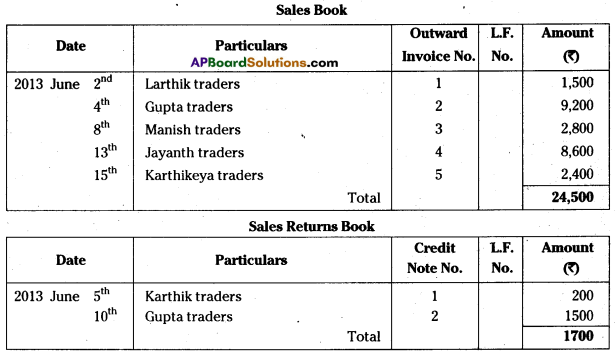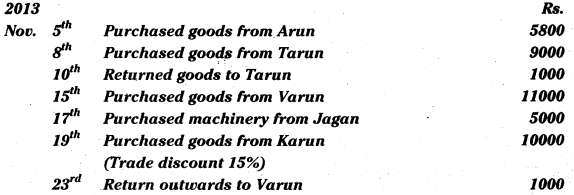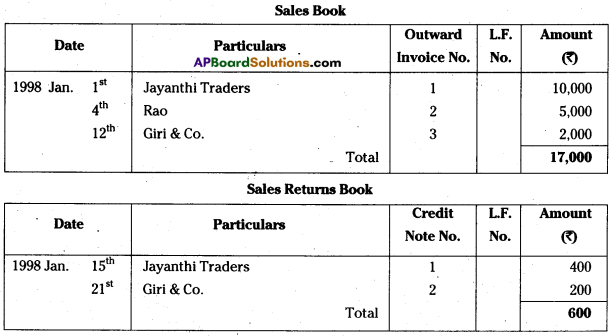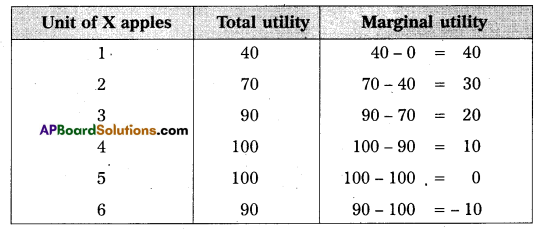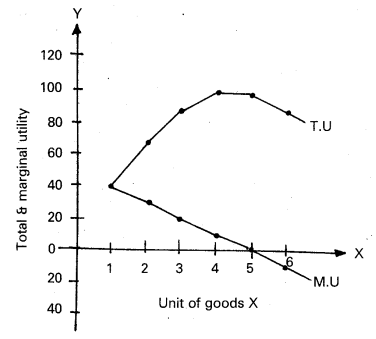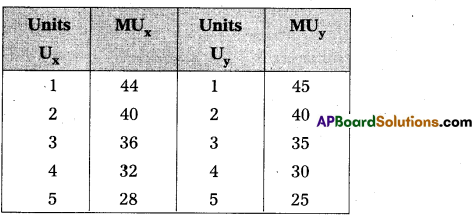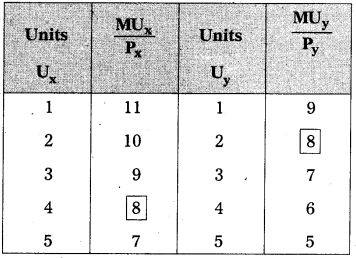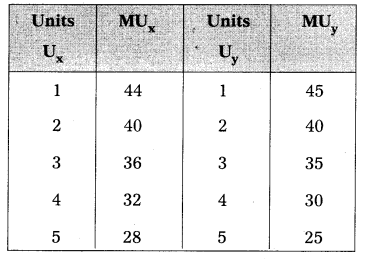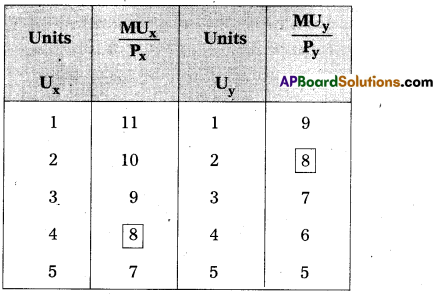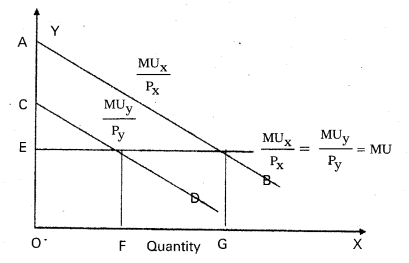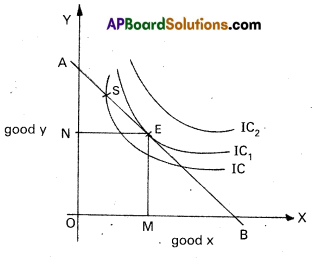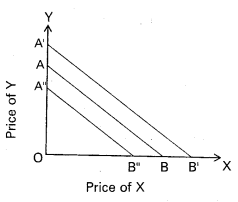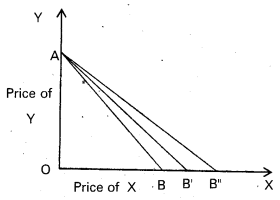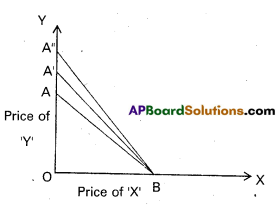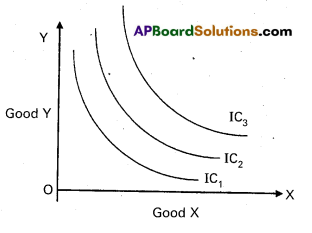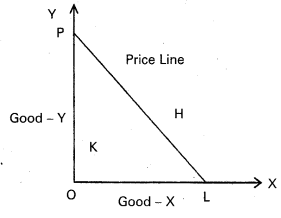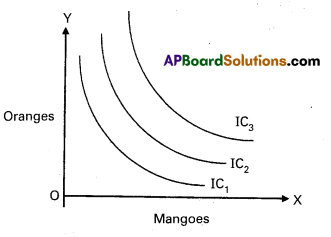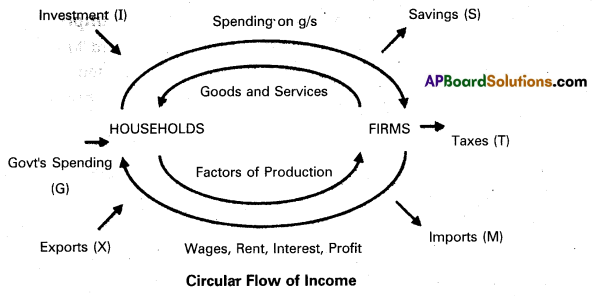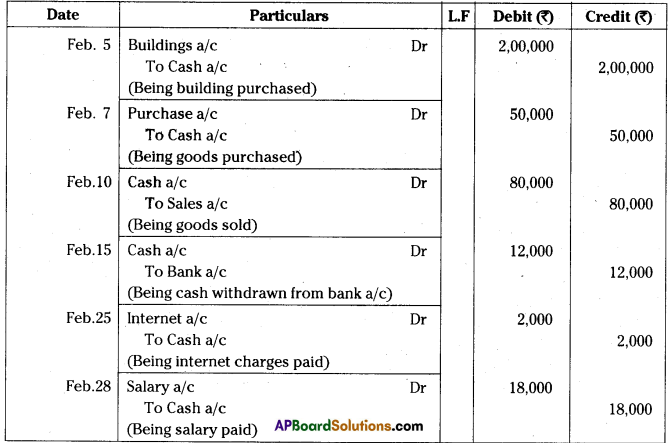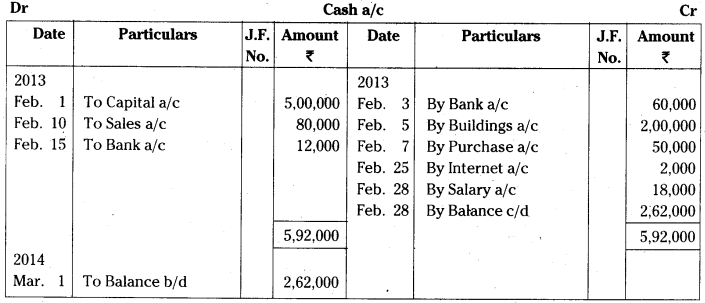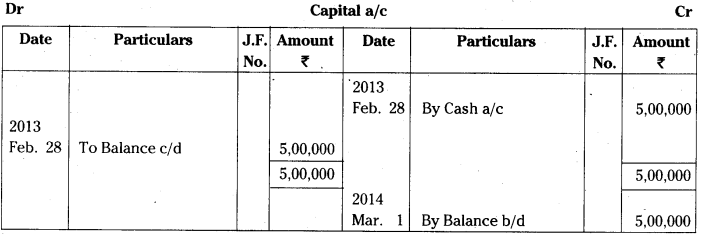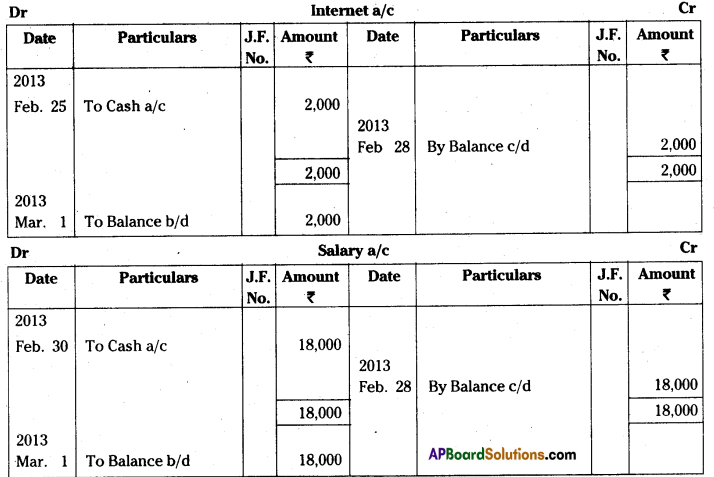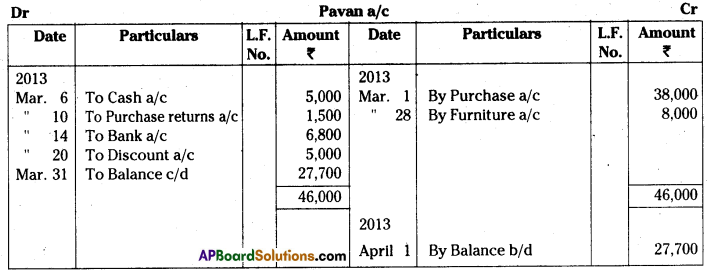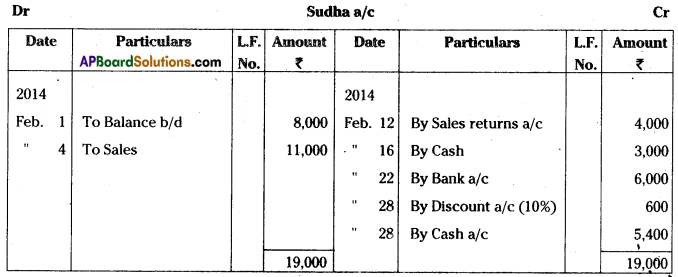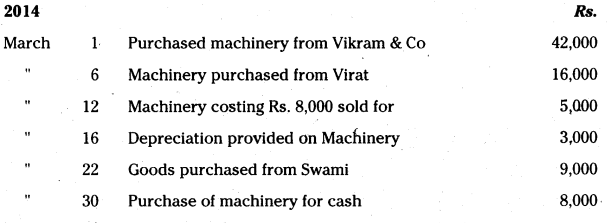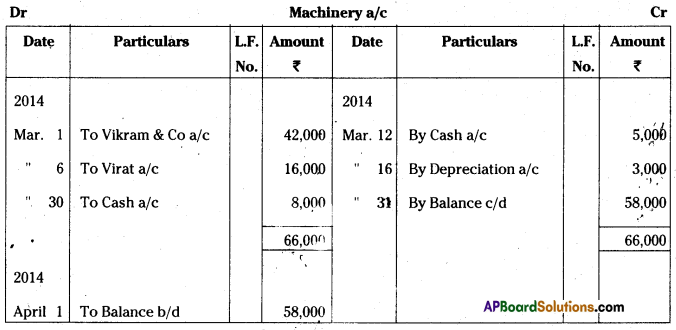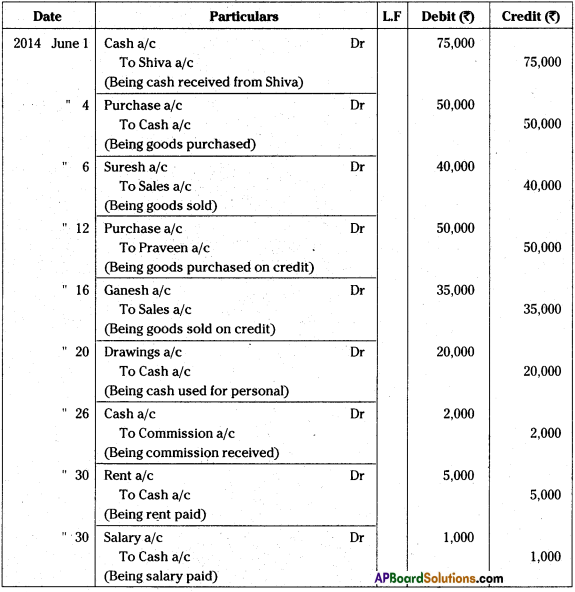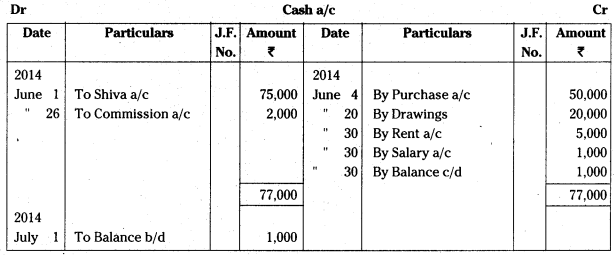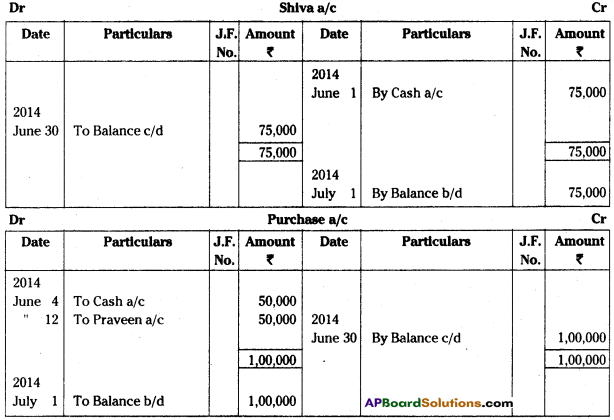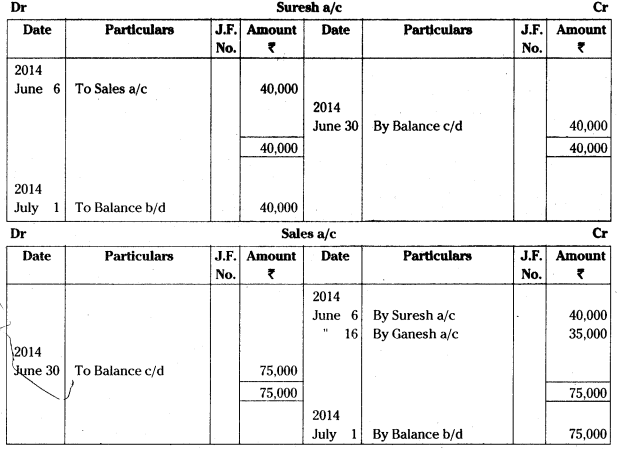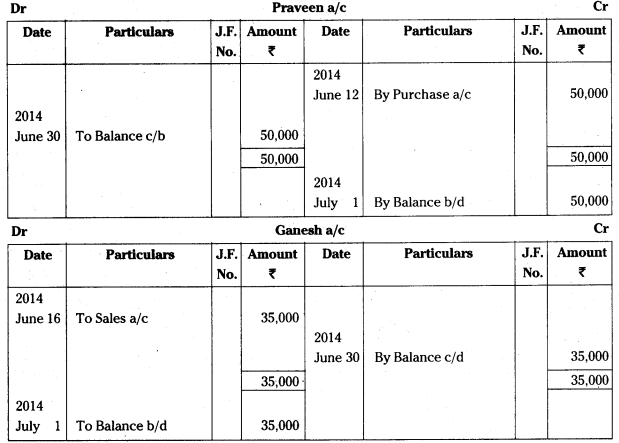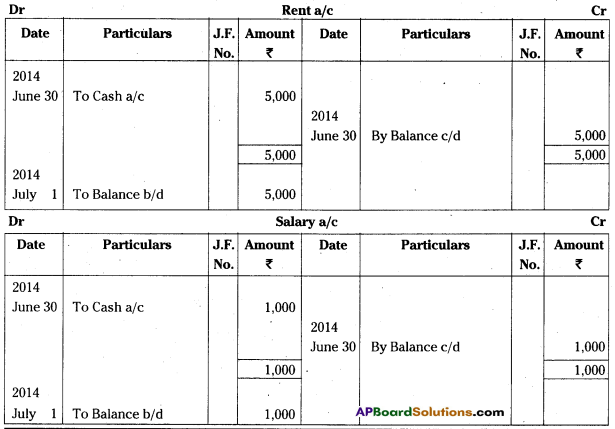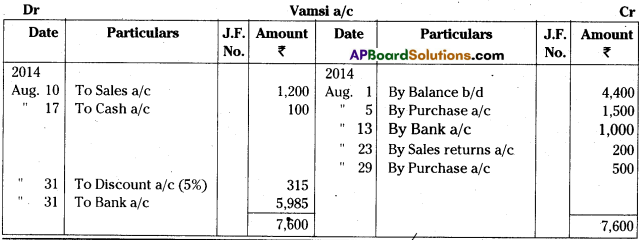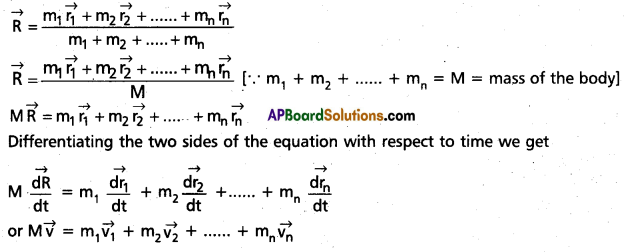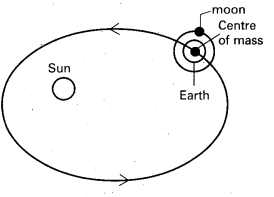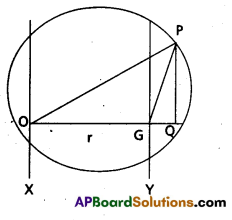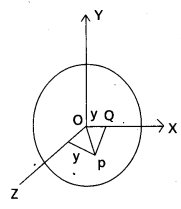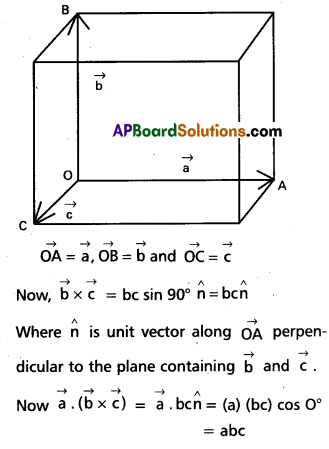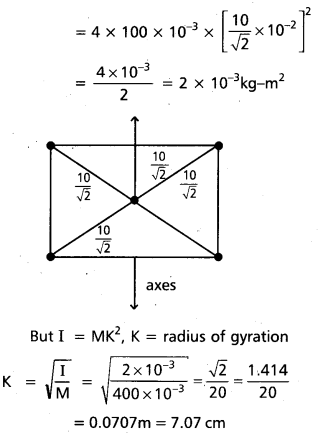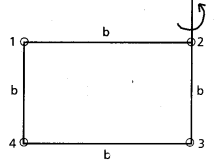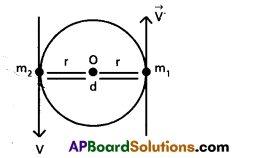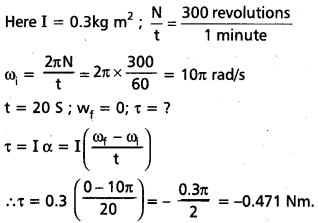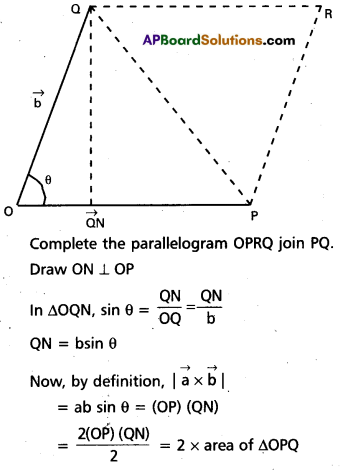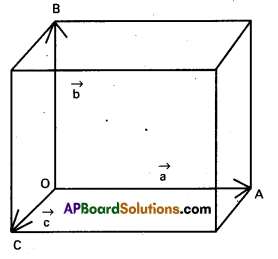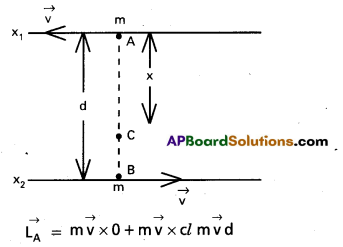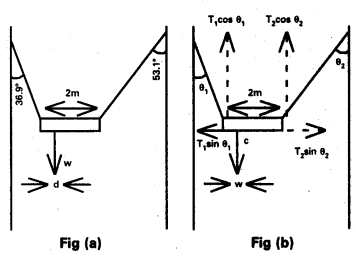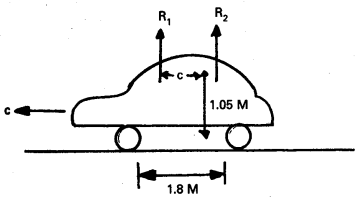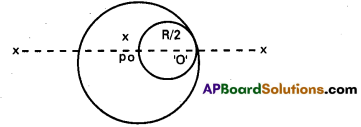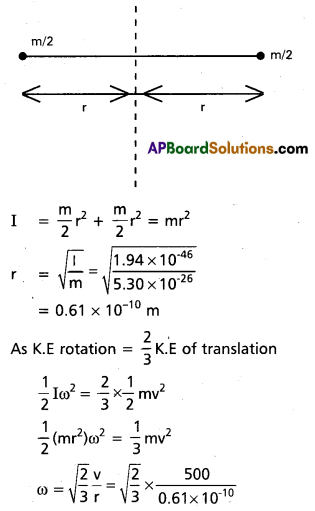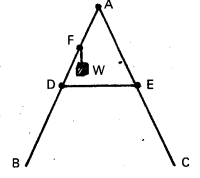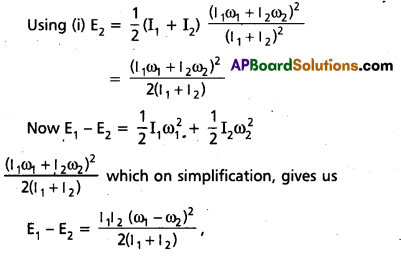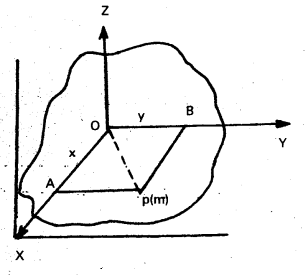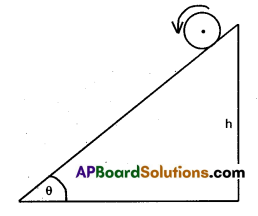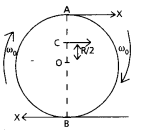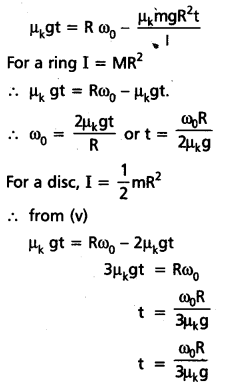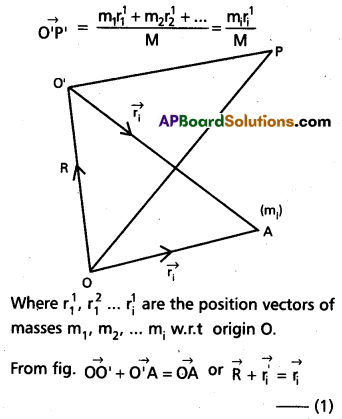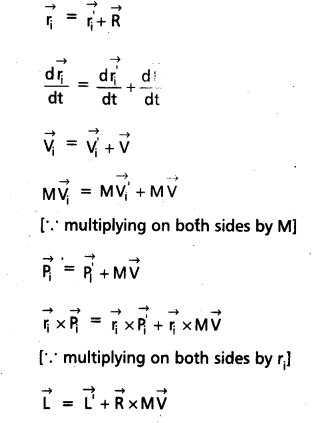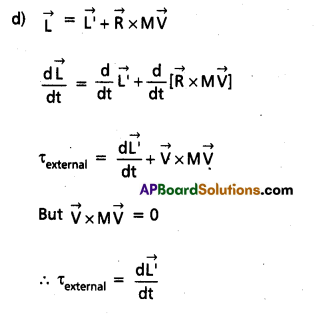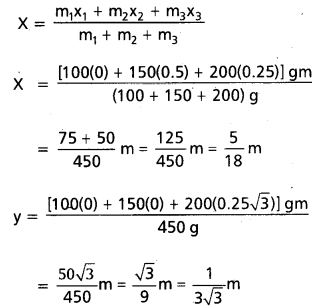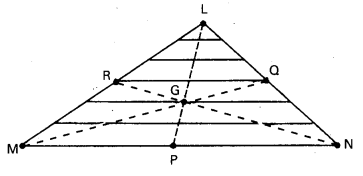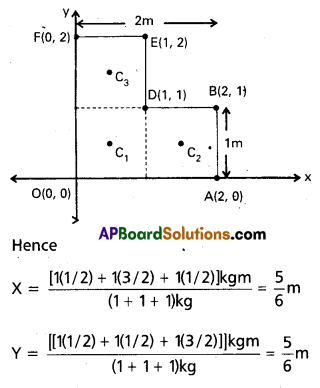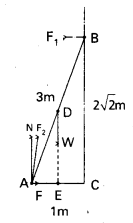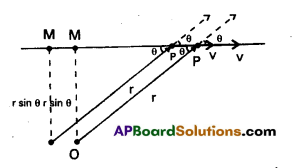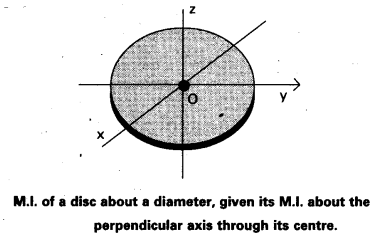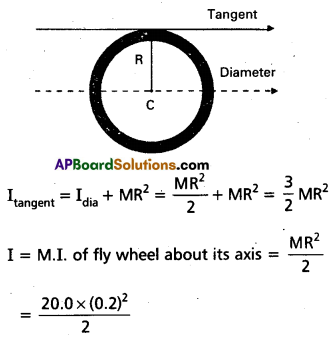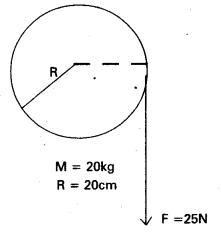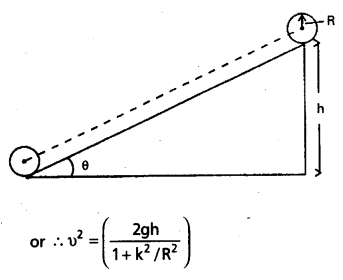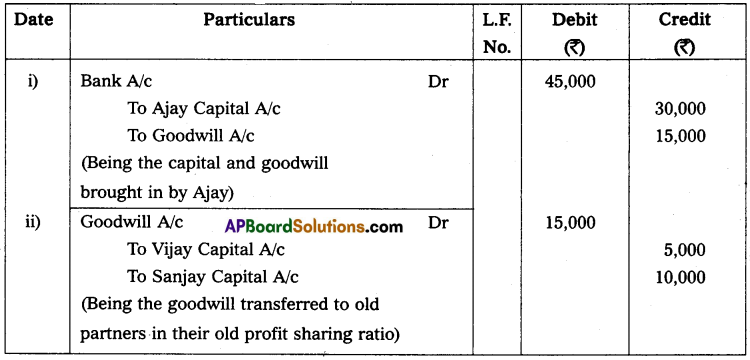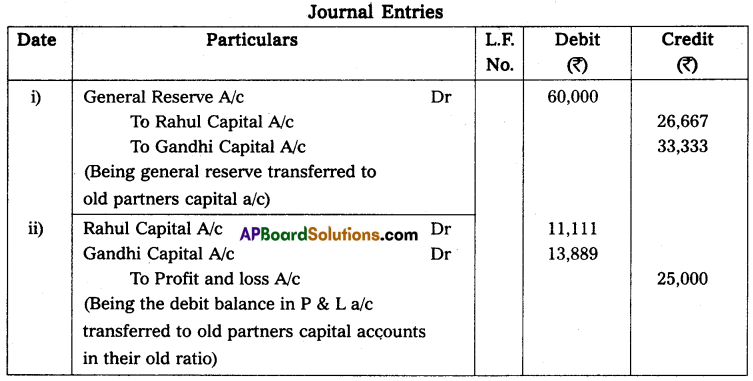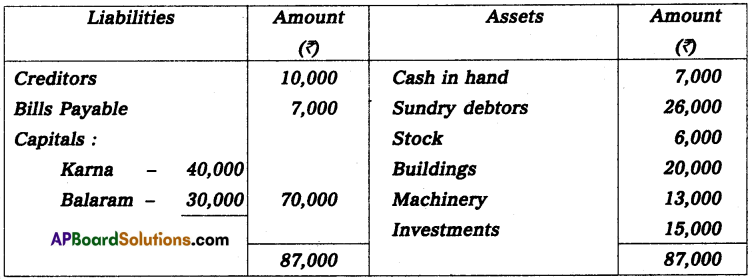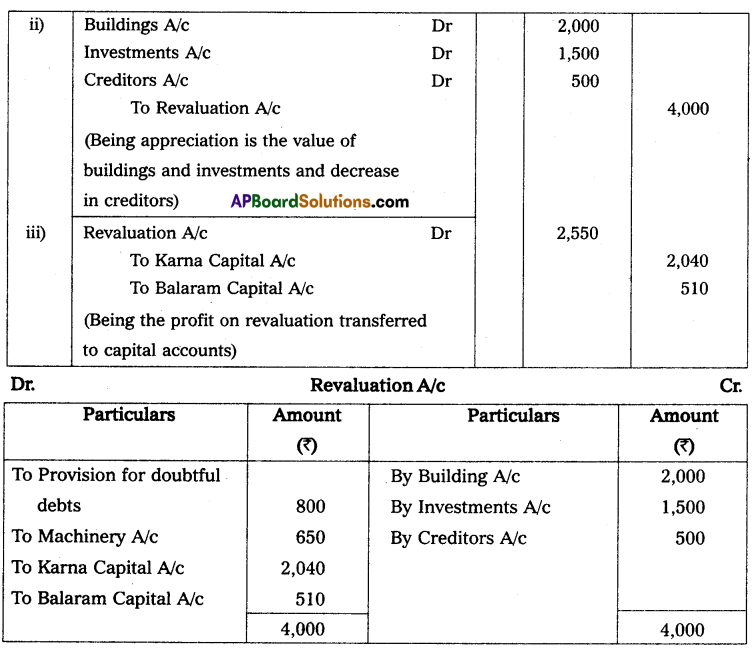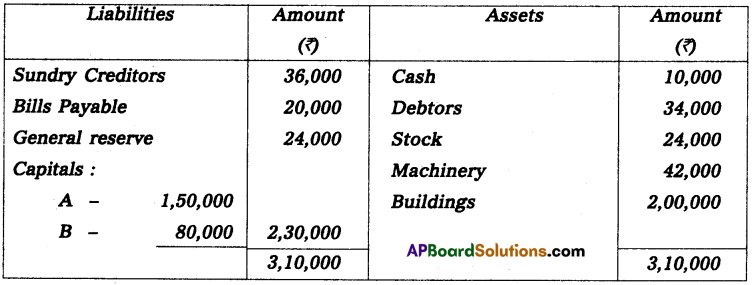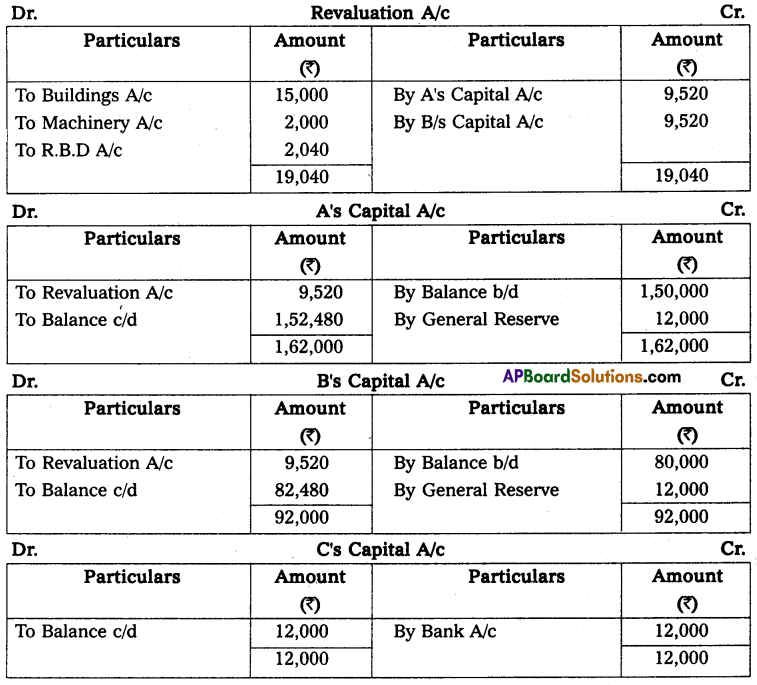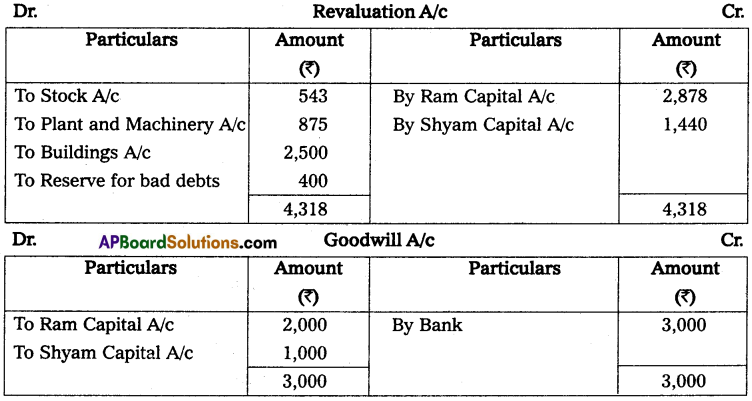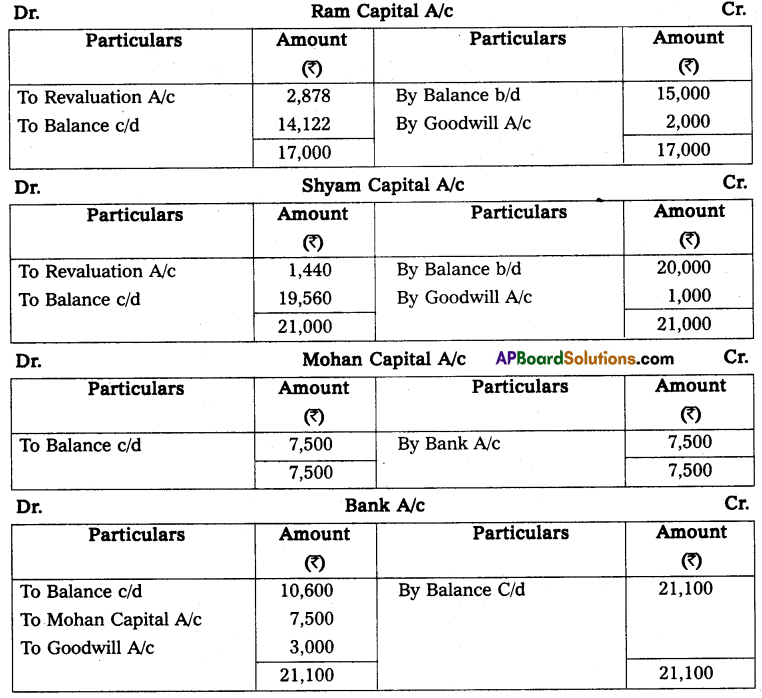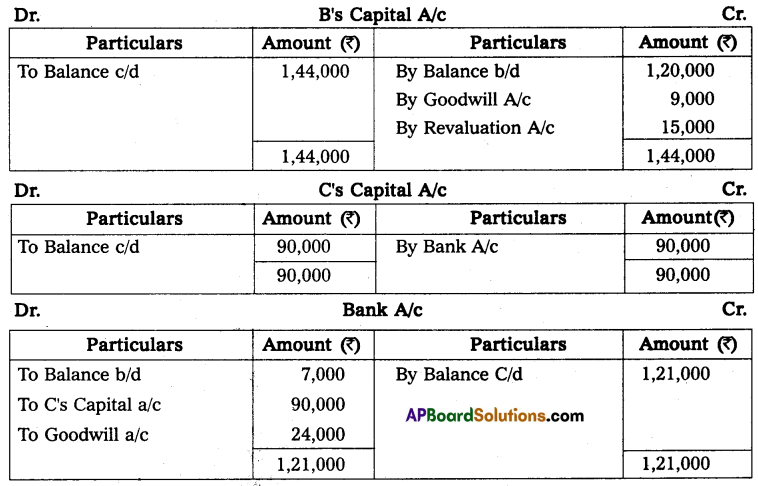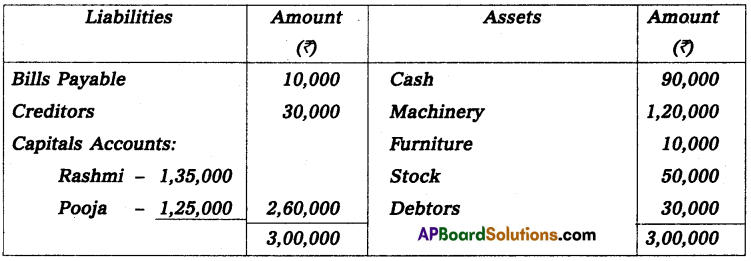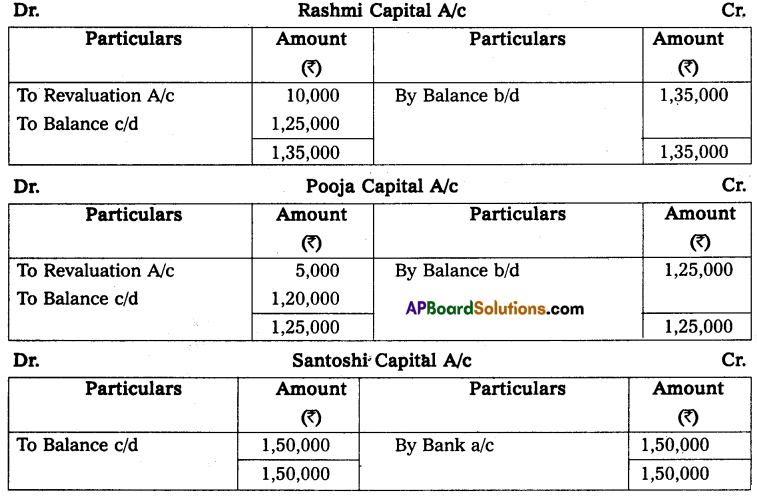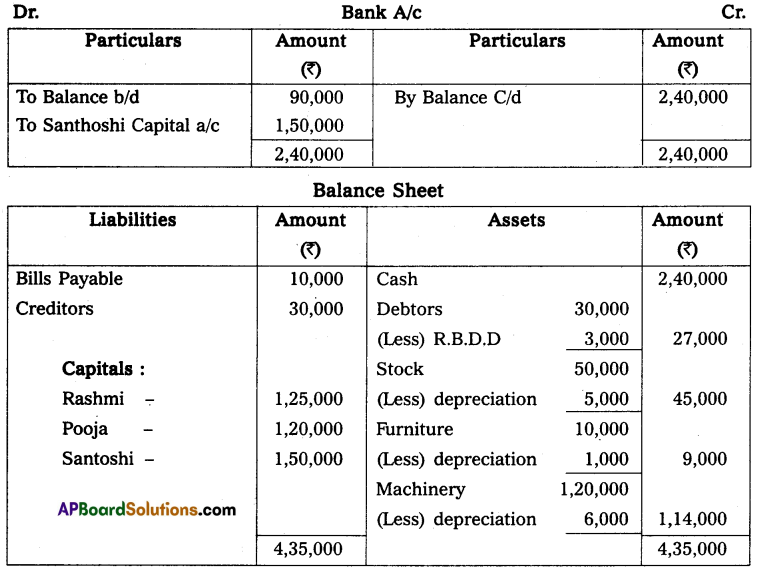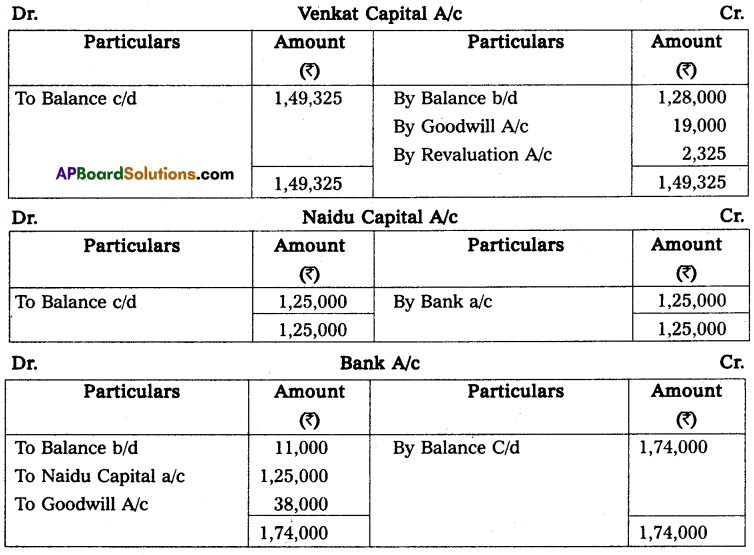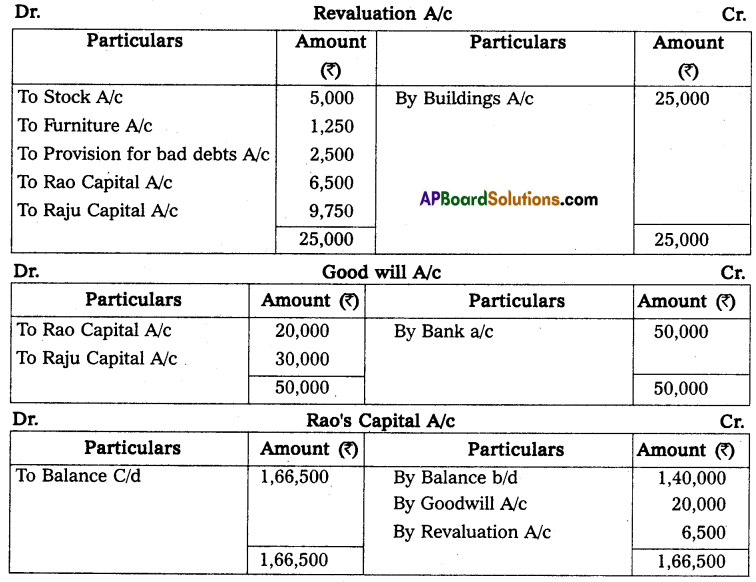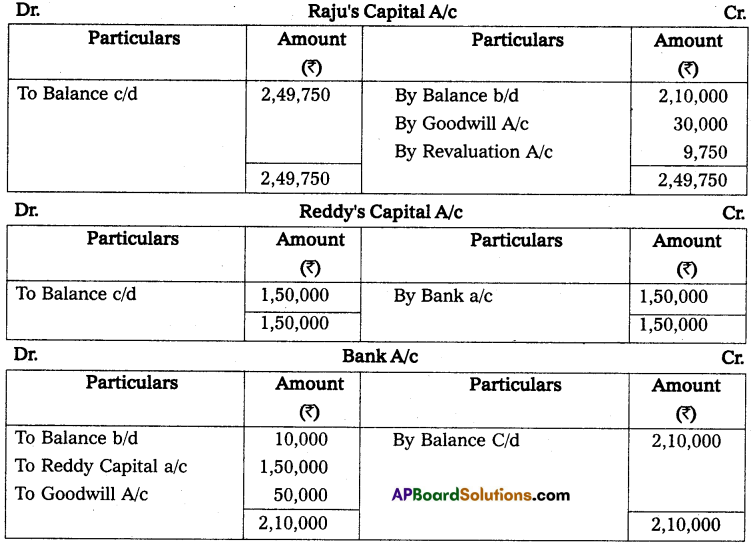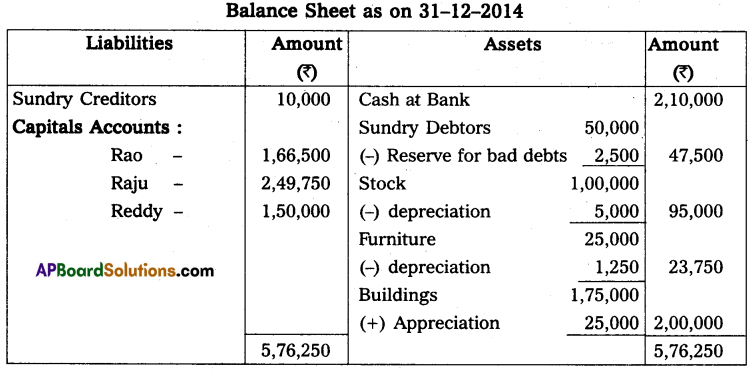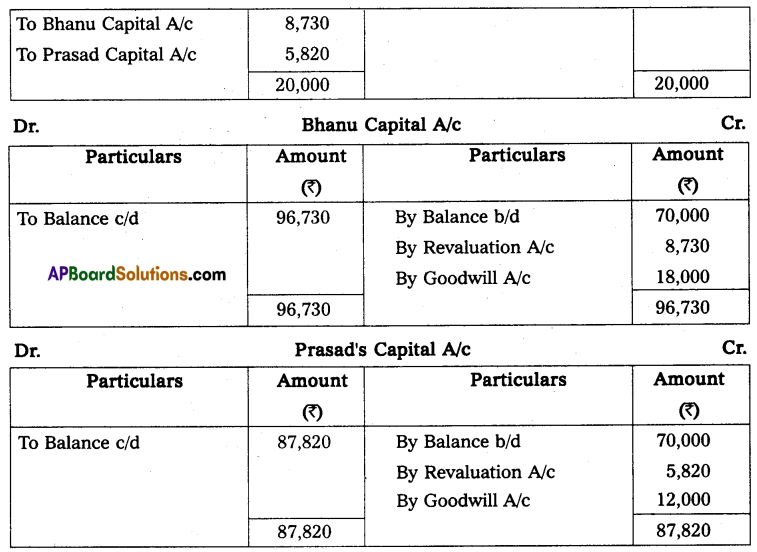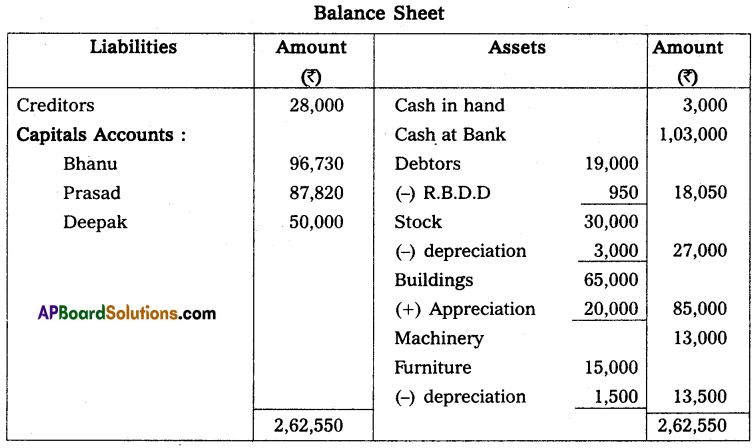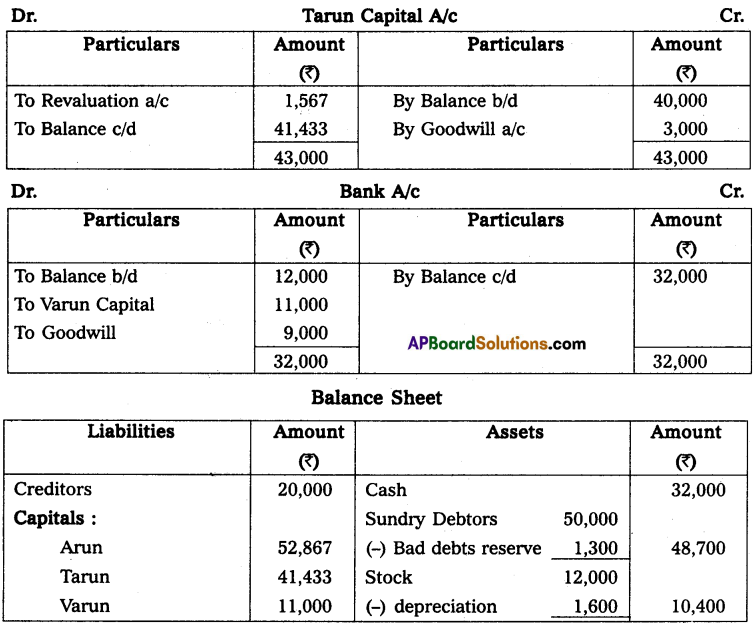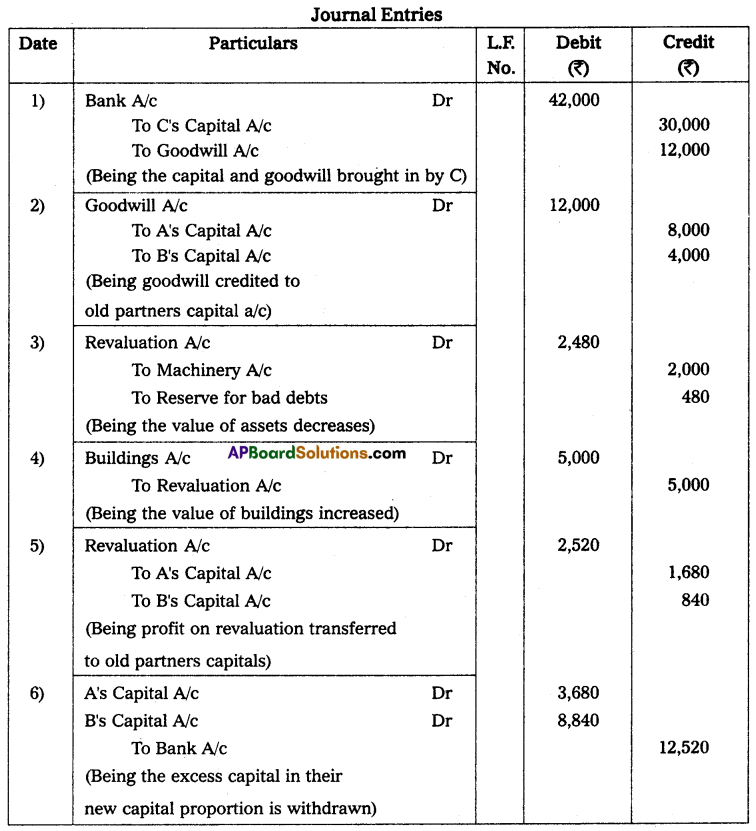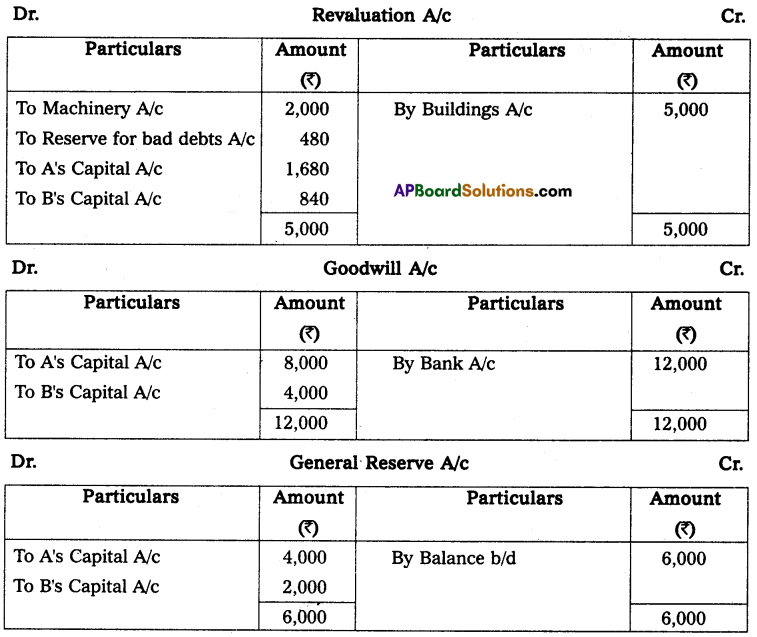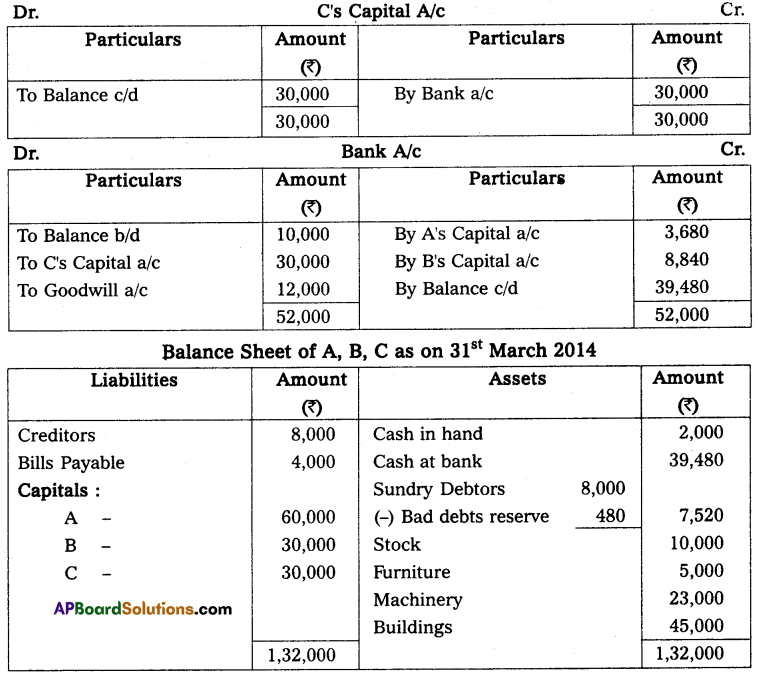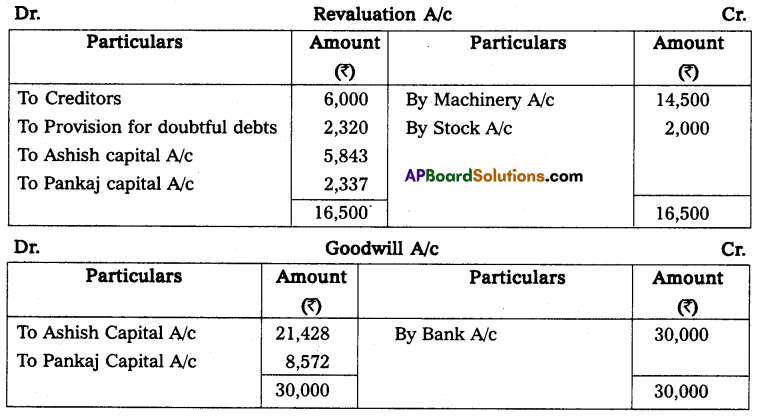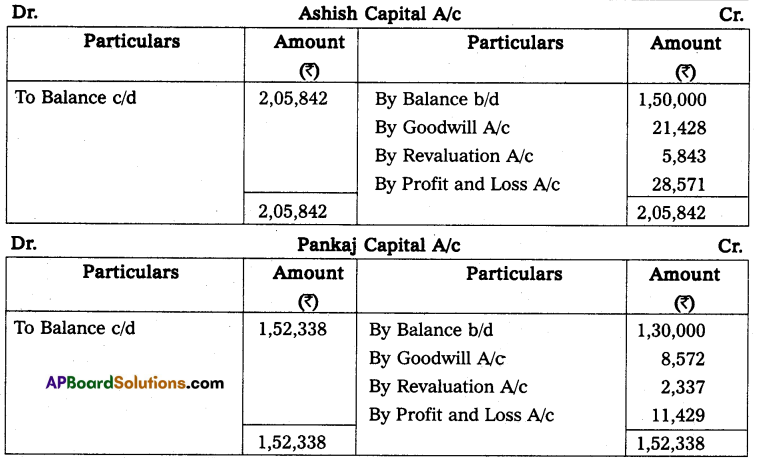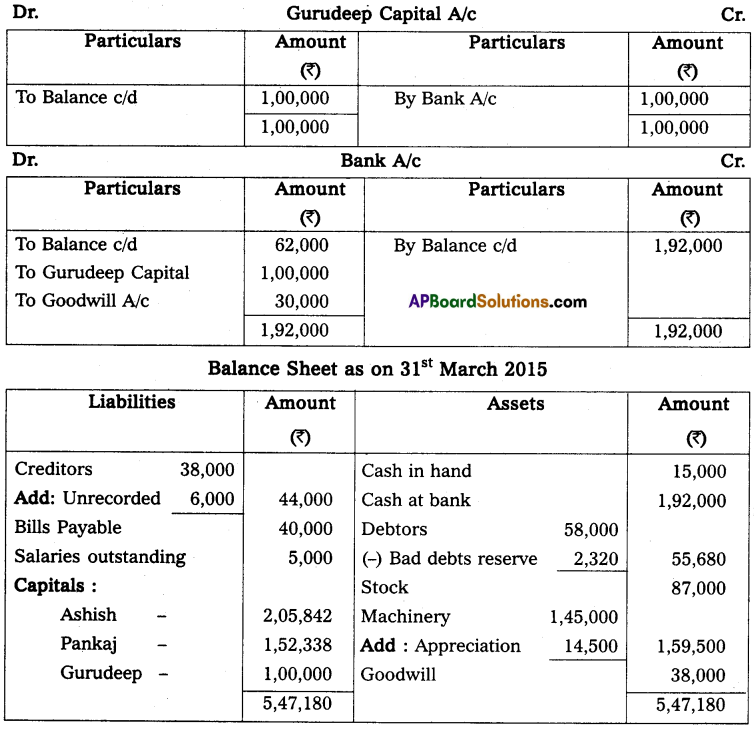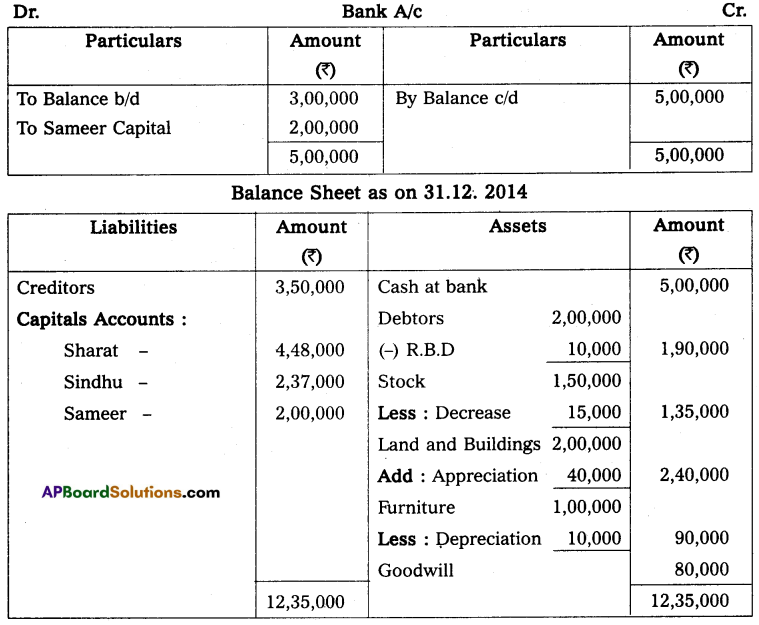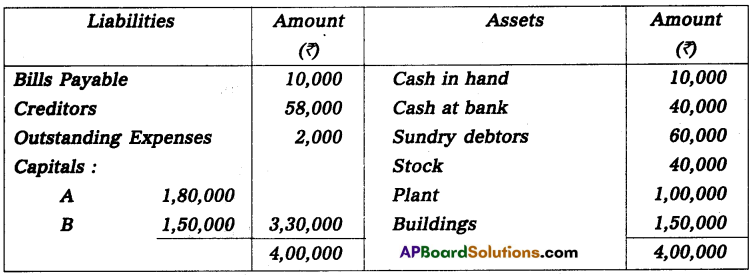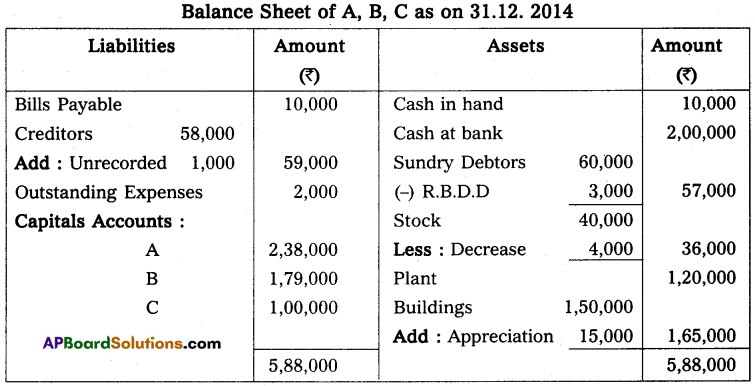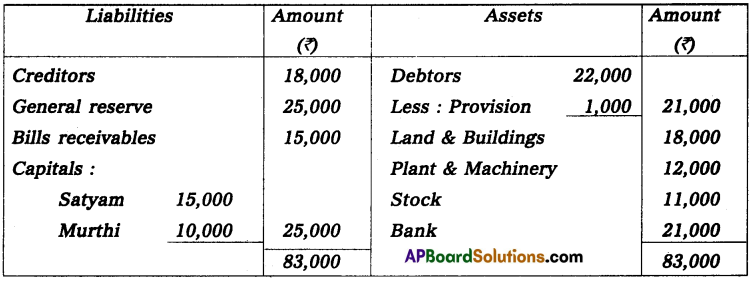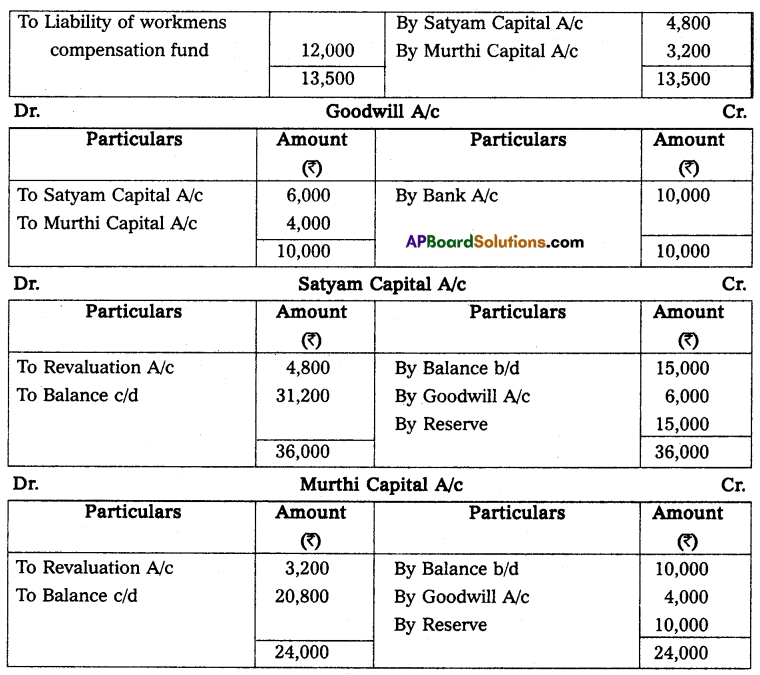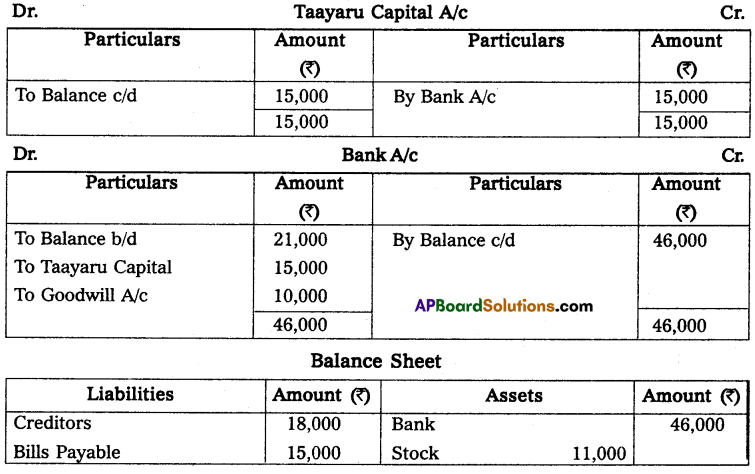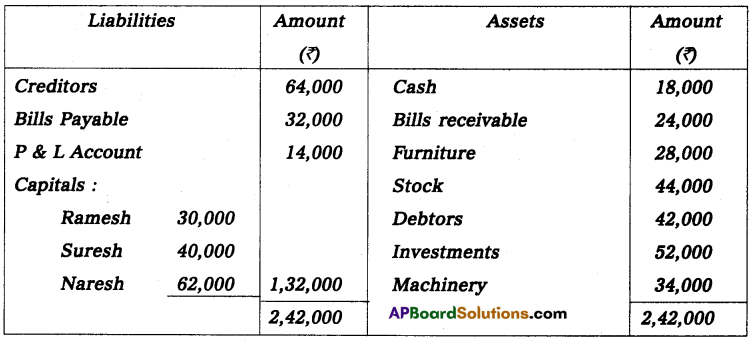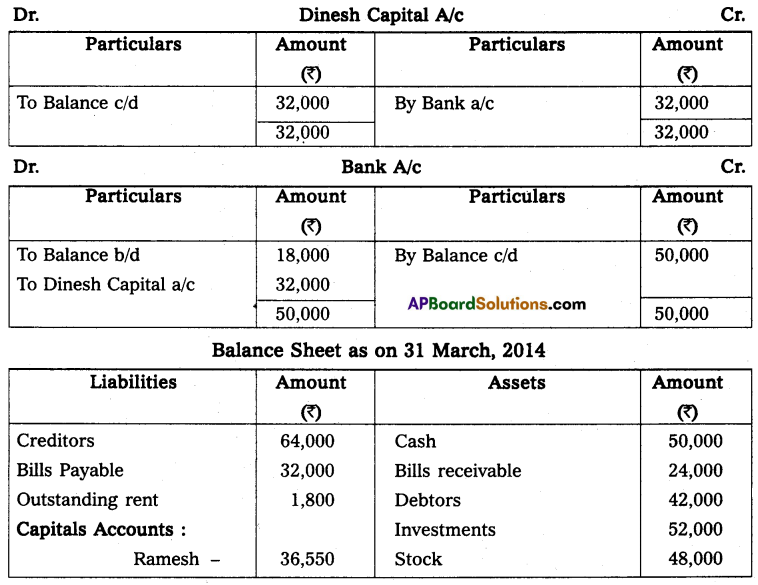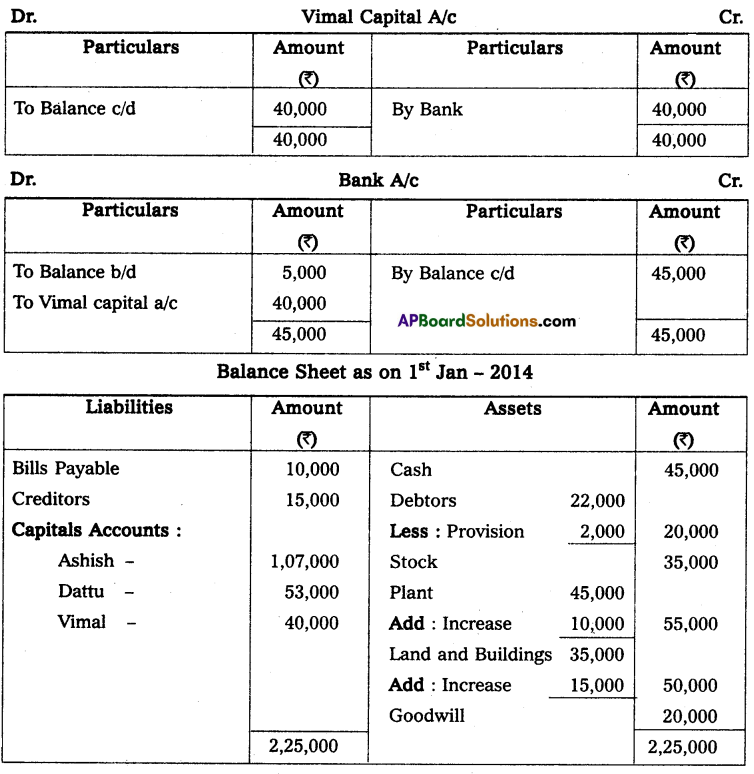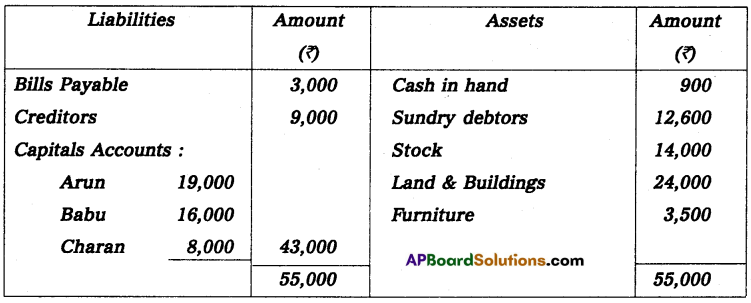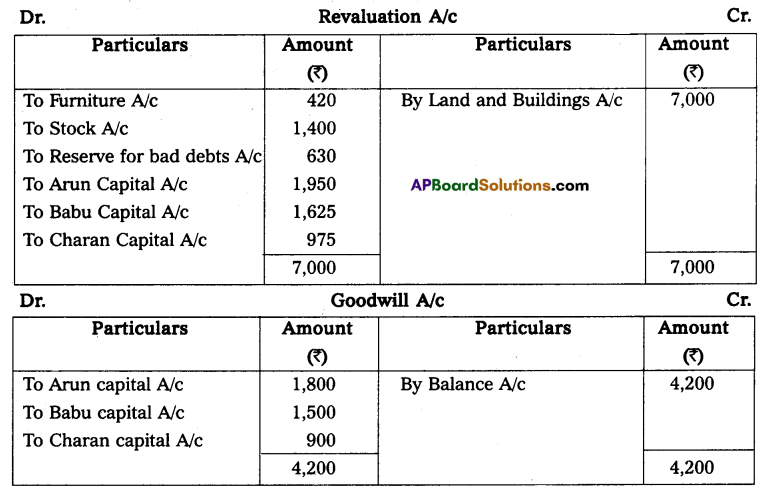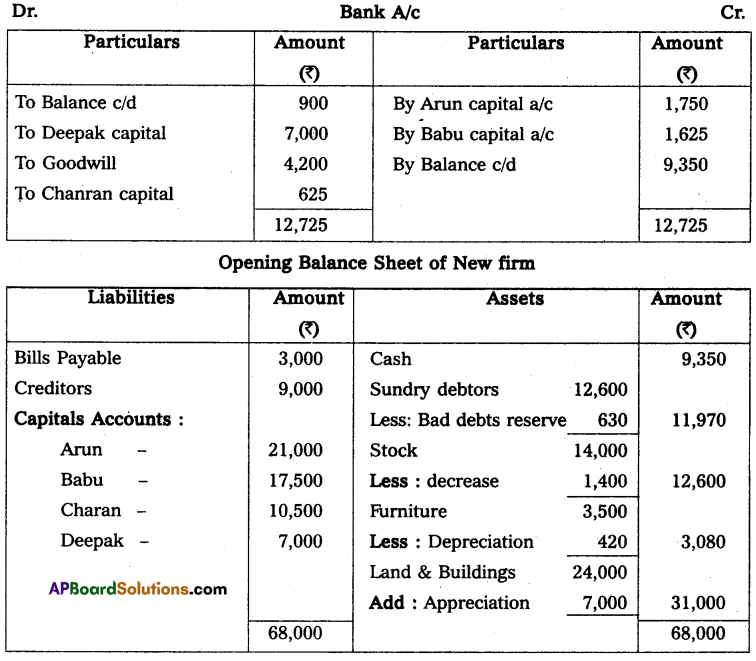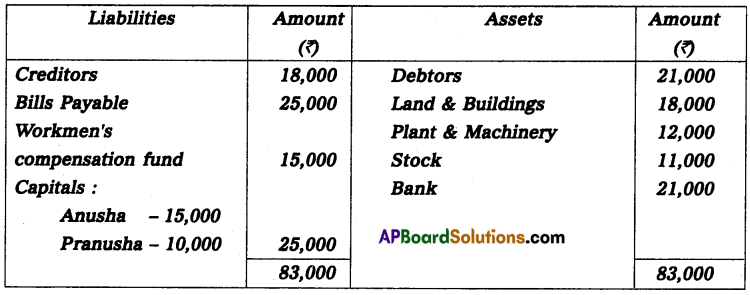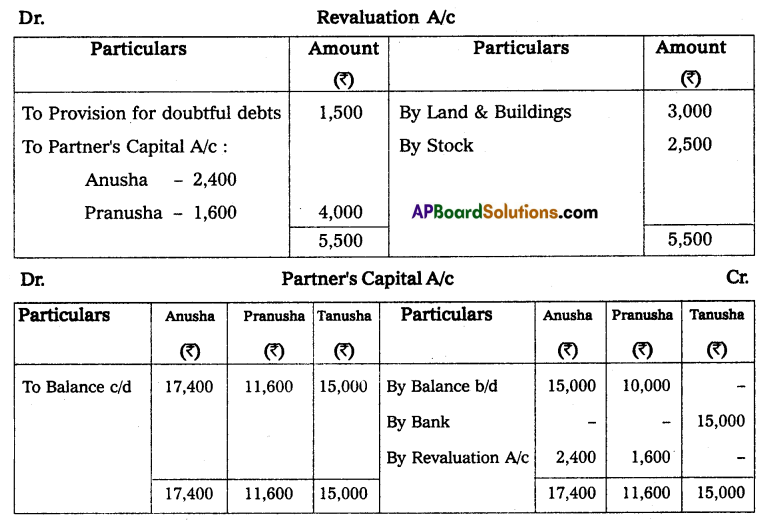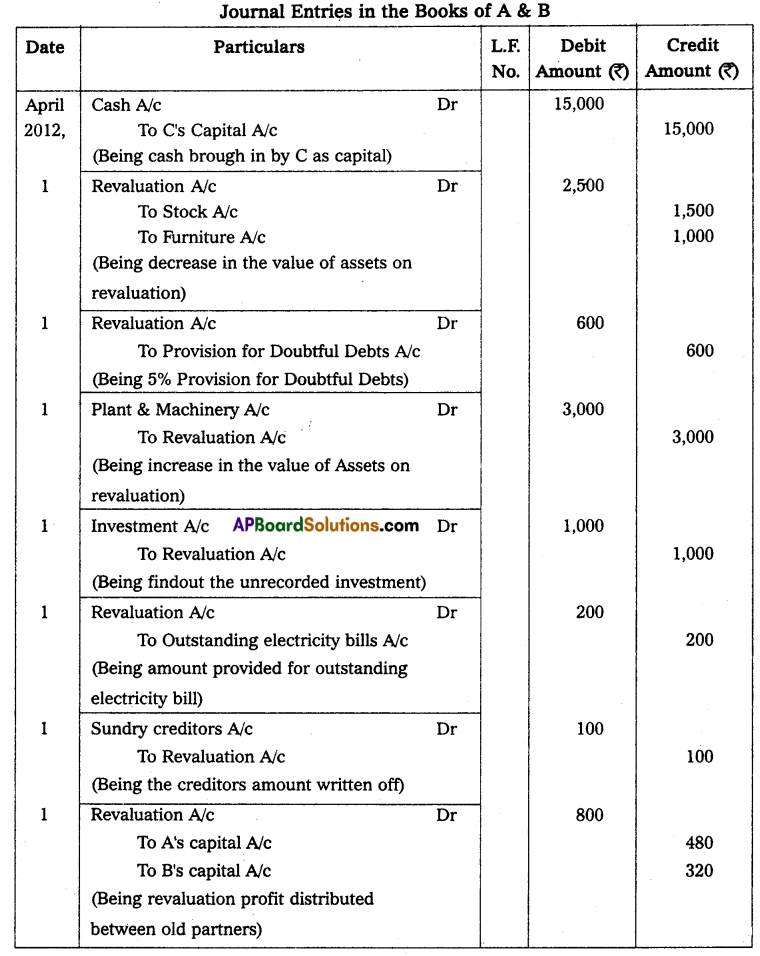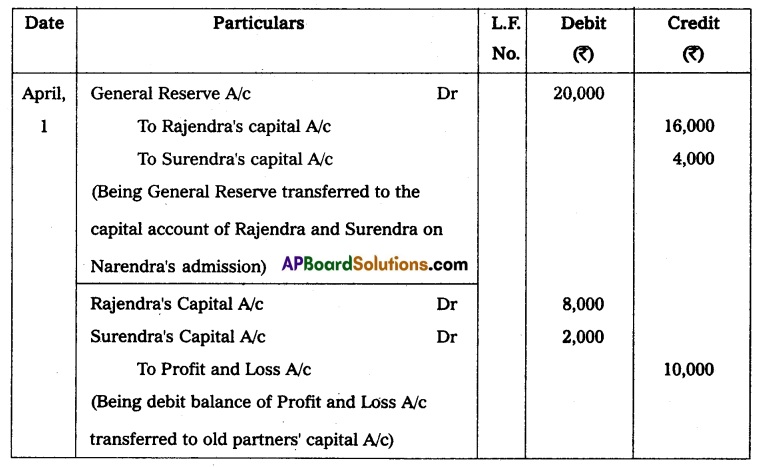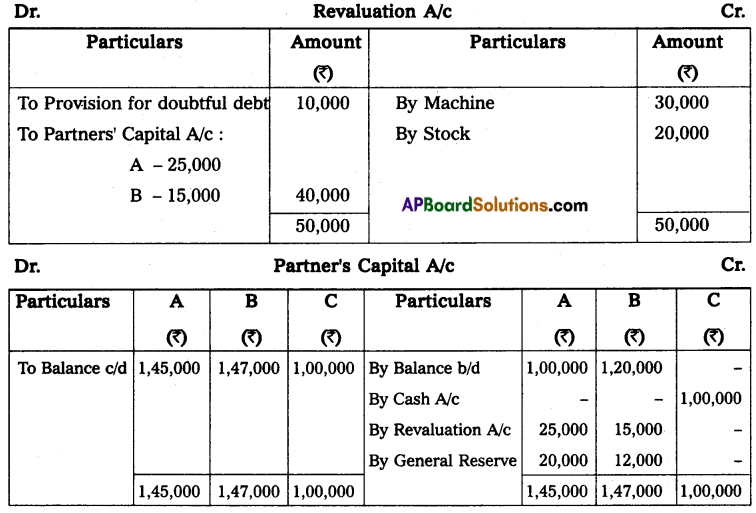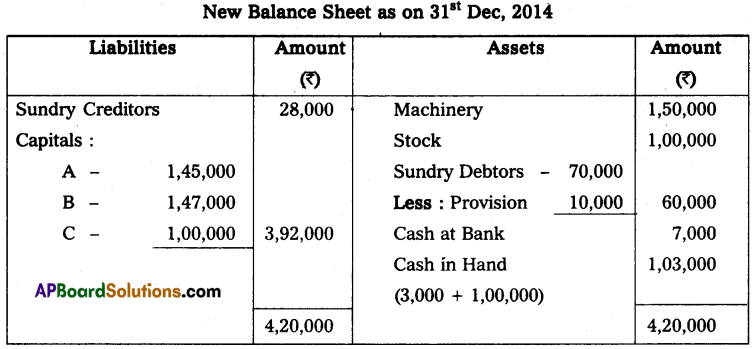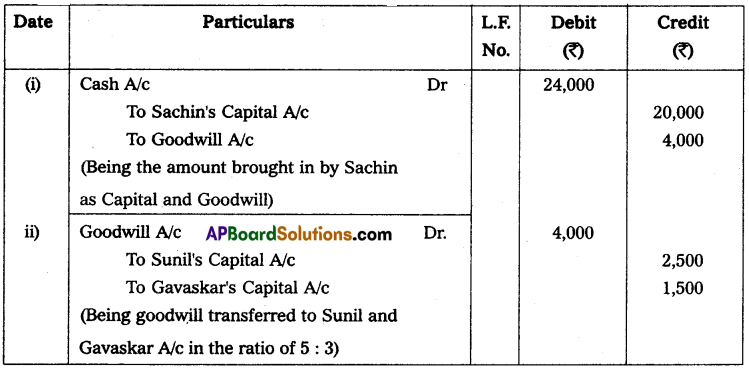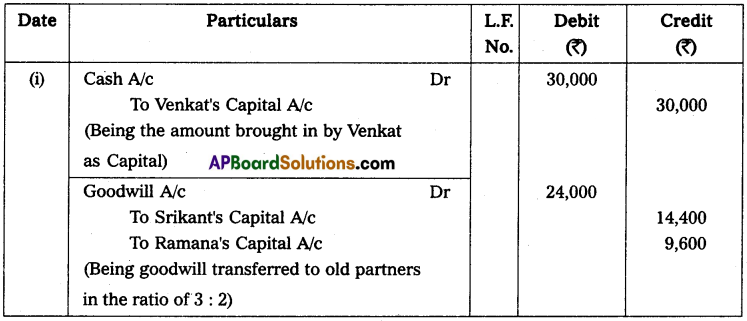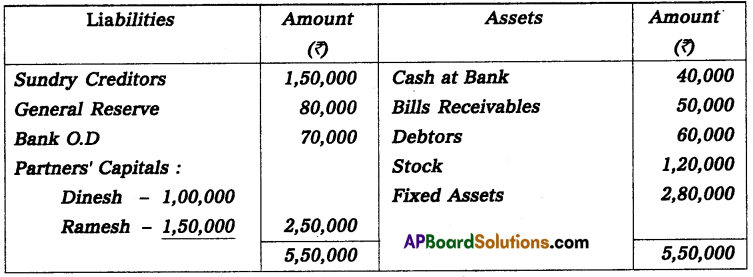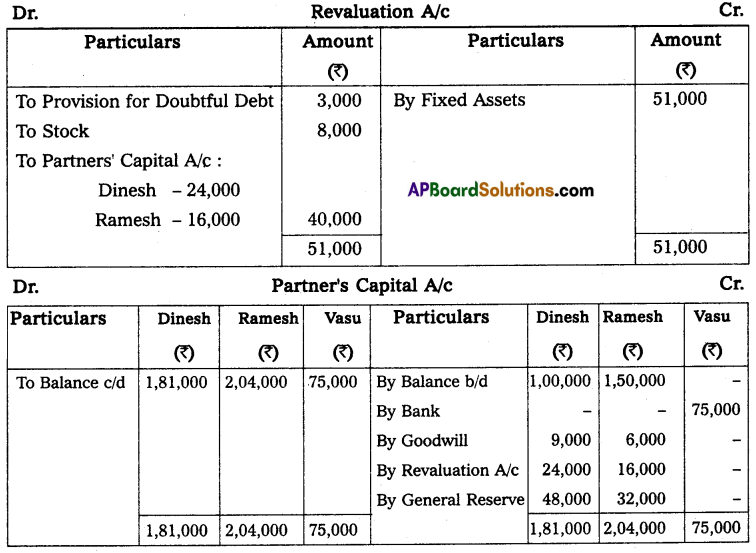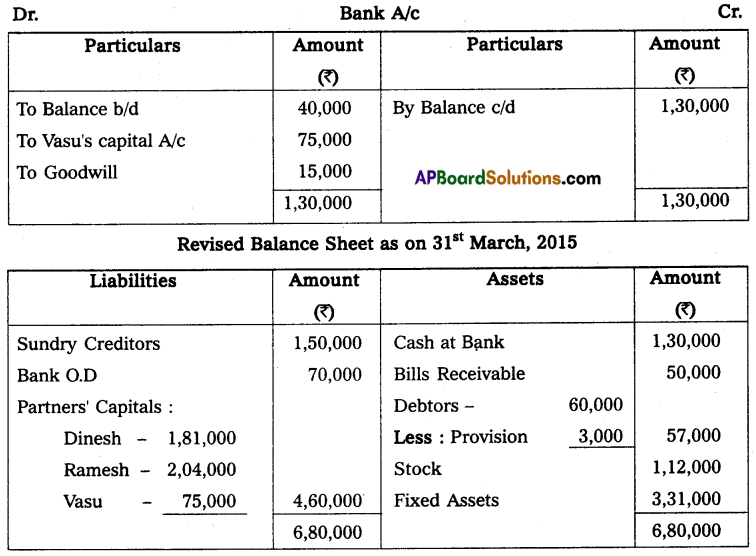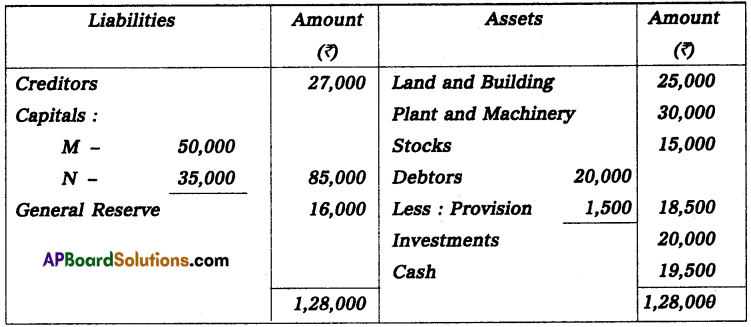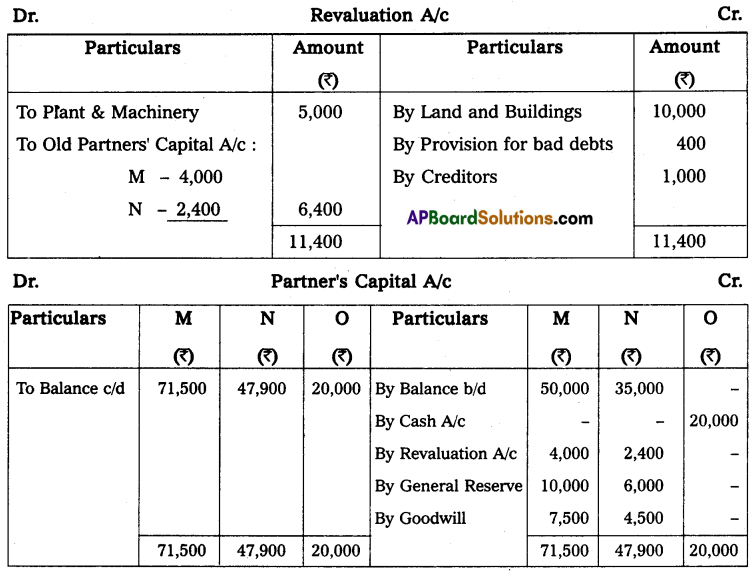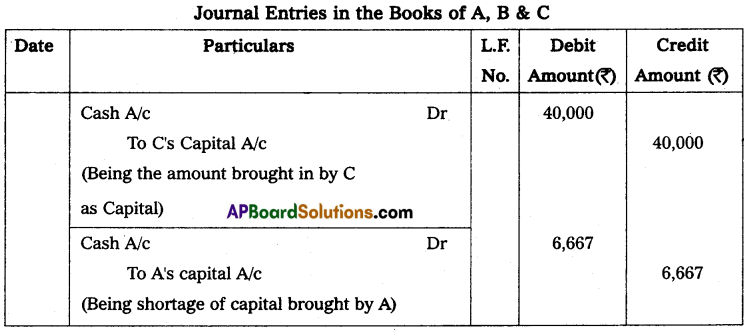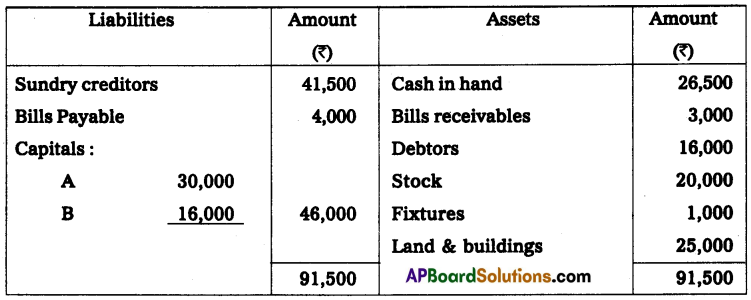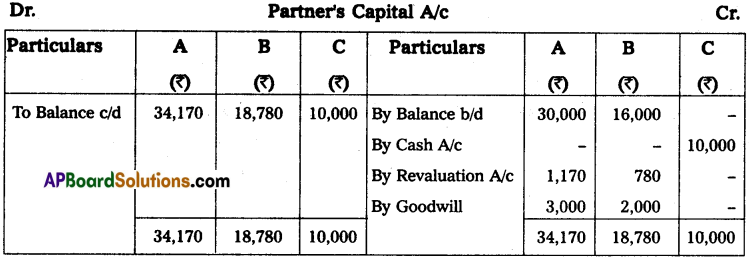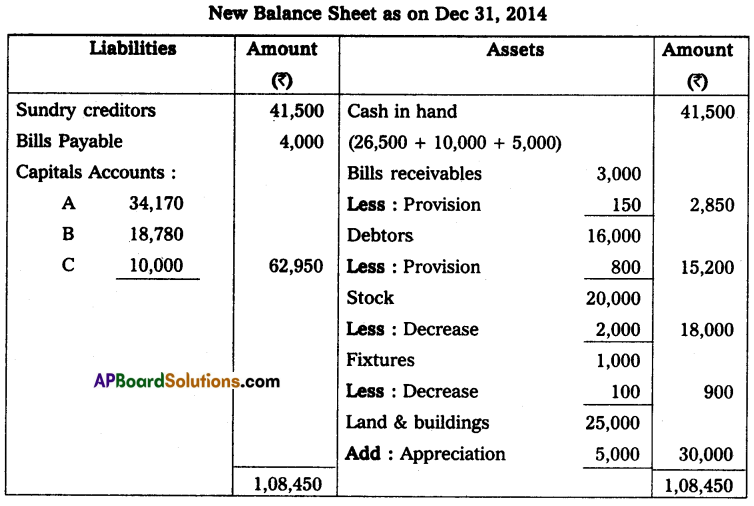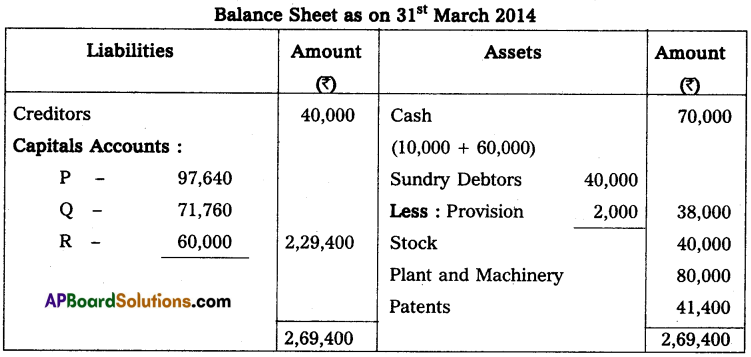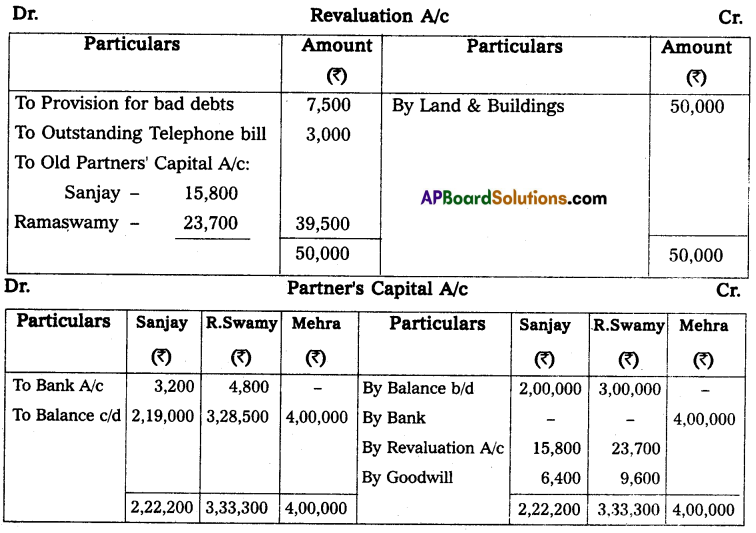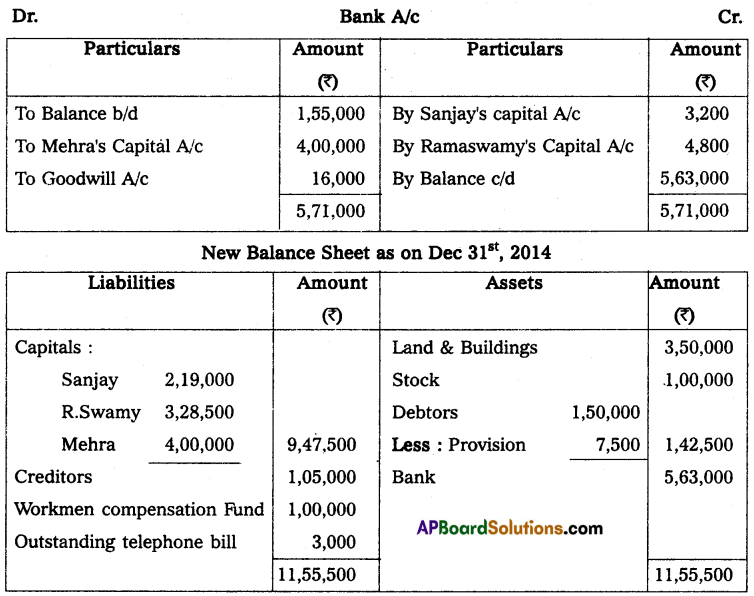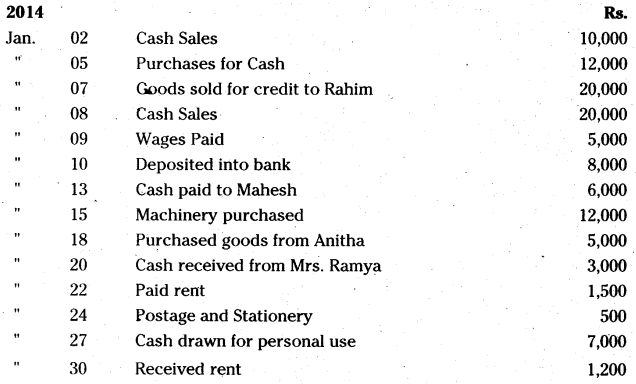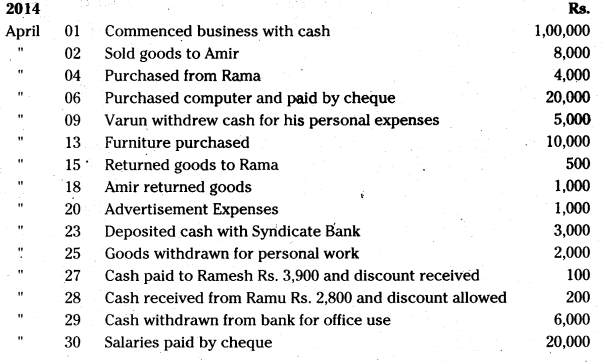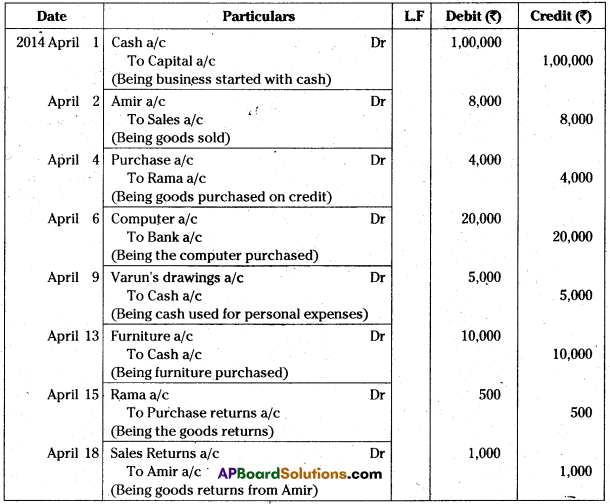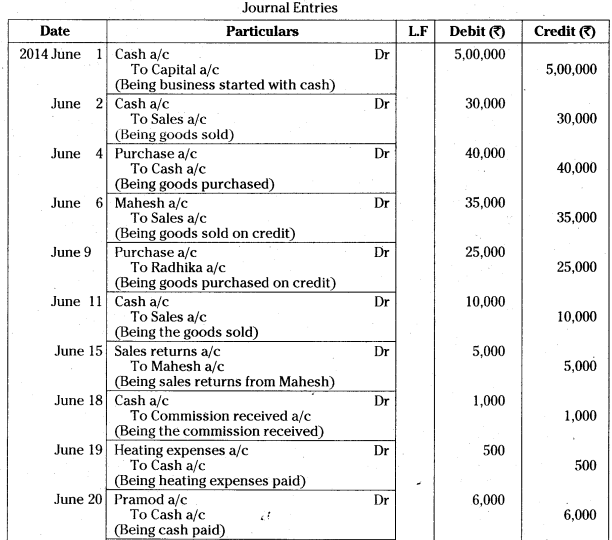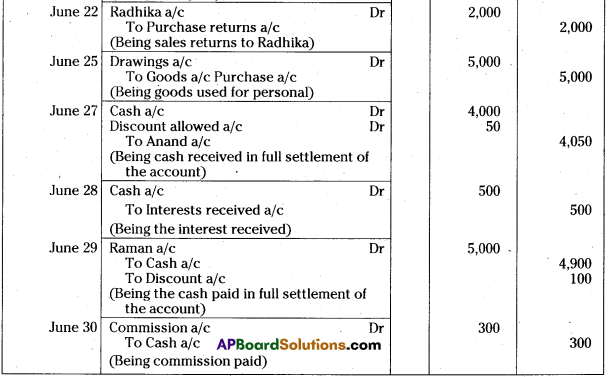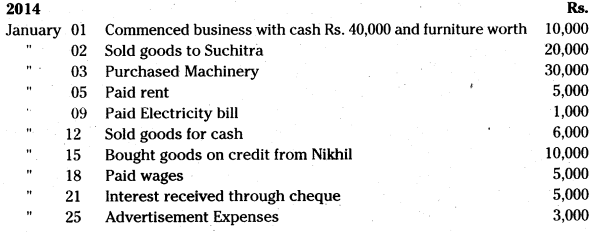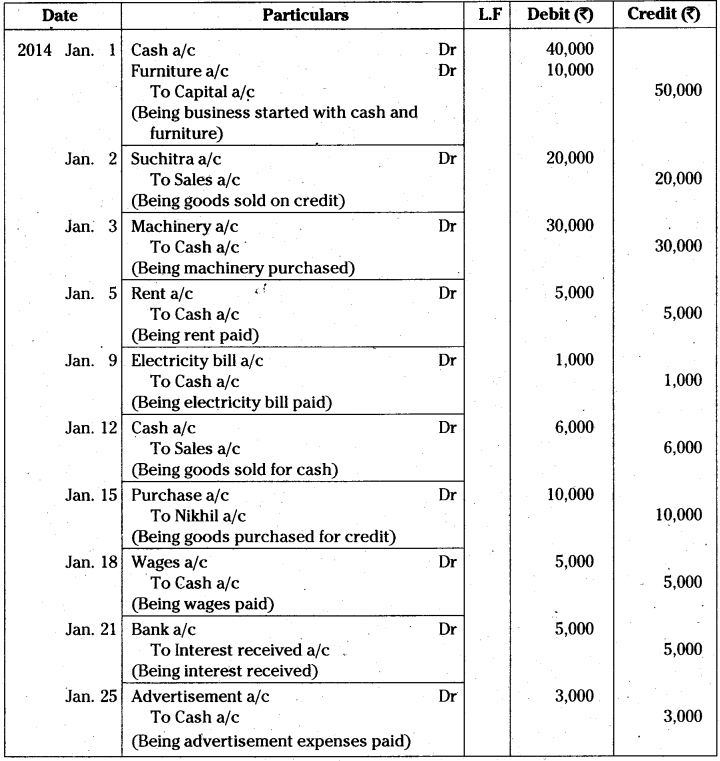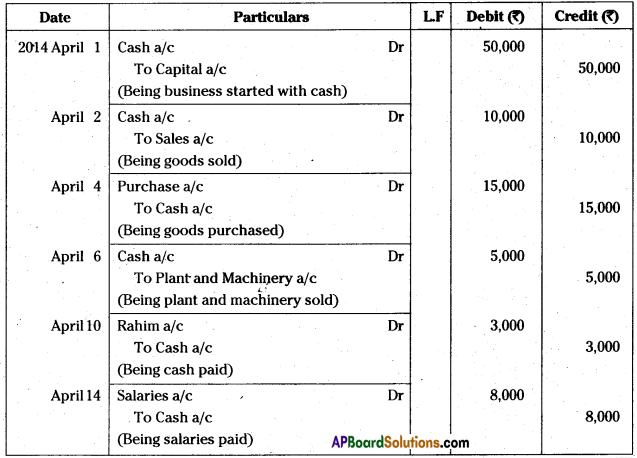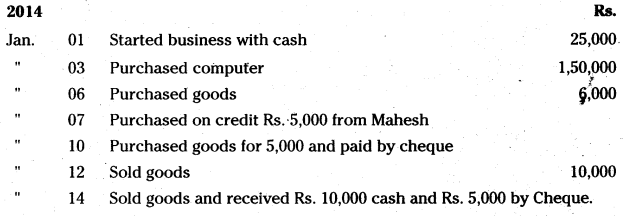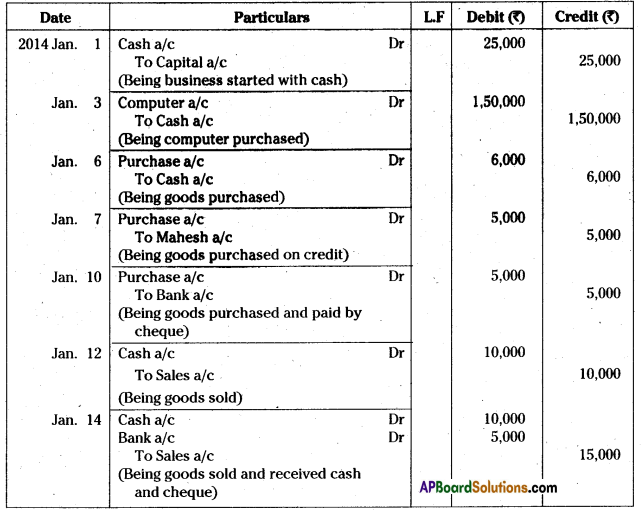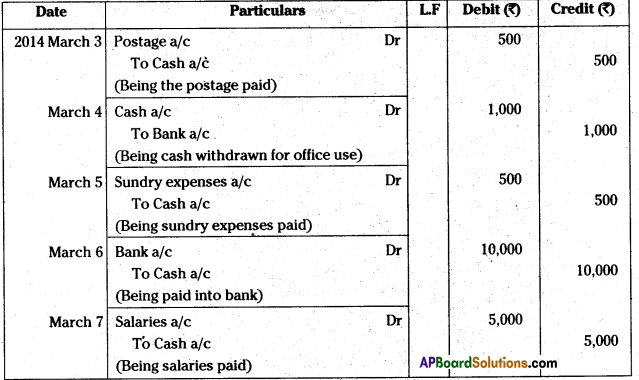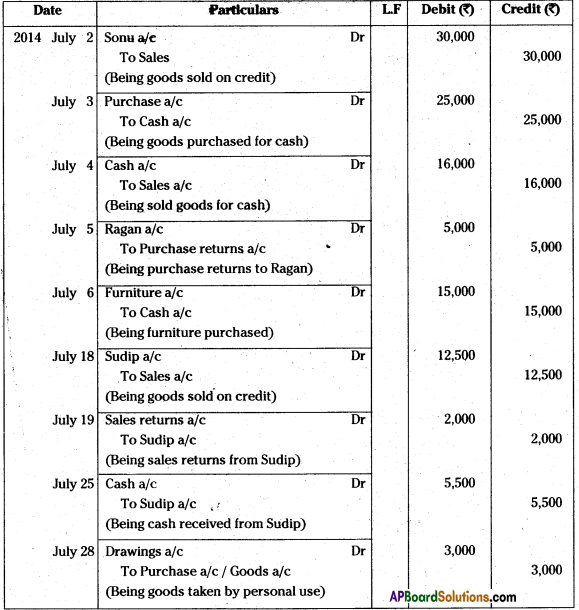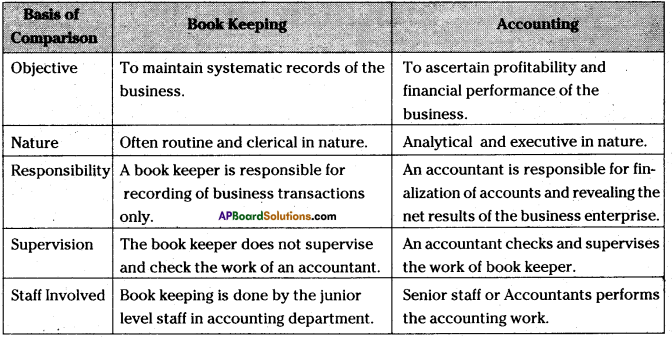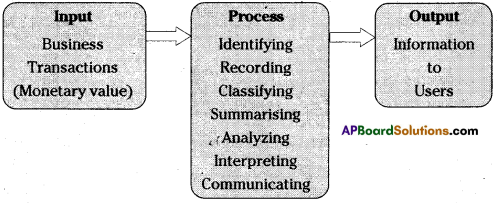Andhra Pradesh BIEAP AP Inter 1st Year Physics Study Material 5th Lesson Laws of Motion Textbook Questions and Answers.
AP Inter 1st Year Physics Study Material 5th Lesson Laws of Motion
Very Short Answer Questions
Question 1.
What is inertia ? What gives the measure of inertia ? [T.S. Mar. 17]
Answer:
The resistance of the body to change its state of rest of state of uniform motion in a straight line is called inertia of the body.
Acceleration = \(\frac{\text { Force }}{\text { Mass }}\)
∴ The more is the mass, less is the acceleration and more is the inertia. The mass of a body is a quantitative measure of its inertia.
Question 2.
According to Newton’s third law, every force is accompanied by an equal and opposite force. How can a movement ever take place ?
Answer:
Because both action and reaction are taking place on different bodies.

Question 3.
When a bullet is fired from a gun, the gun gives a kick in the backward direction. Explain. [A.P. Mar. 15]
Answer:
Due to law of conservation of momentum, Recoil of the gun V = \(\frac{\mathrm{mu}}{\mathrm{M}}\)
Where M – mass of the gun; m = mass of the bullet; u = velocity of the bullet
Question 4.
Why does a heavy rifle not recoil as strongly as a light rifle using the same cartridges ?
Answer:
Recoil of the Gun V = \(\frac{\mathrm{mu}}{\mathrm{M}}\)
Due to heavy mass of rifle the recoil is less.
Question 5.
If a bomb at . _st explodes into two pieces, the pieces must travel in opposite directions. Explain. [T.S. Mar. 16, 15]
Answer:
According to law of conservation of momentum,
Mu = m1v1 + m2v2
Initially the bomb is at rest u = 0
m1v1 + m2v2 = 0
or m1v1 – m2v2
(Negative sign indicates that the pieces must travel in opposite direction)
Question 6.
Define force. What are the basic forces in nature ?
Answer:
The force is on which changes or tends to change the state of rest or motion of a body. Basic forces :
- Gravitational force
- Electromagnetic force
- Nuclear force
- Weak interaction force

Question 7.
Can the coefficient of friction be greater than one ?
Answer:
Yes, coefficient of friction may be greater than one. In some particular cases it is possible. They are
- Due to increase the inner molecular attractive forces between surfaces when the contact surfaces are highly polished.
- When the contact surfaces of the bodies are inter locking the coefficient friction may be greater than one.
Question 8.
Why does the car with a flattened tyre stop sooner than the one with inflated tyres ?
Answer:
Flattened deforms more than the inflated tyre. Due to greater deformation of the type rolling friction is large nence it stops soon.
Question 9.
A horse has to pull harder during the start of the motion than later. Explain. [Mar. 13]
Answer:
We know the limiting frictional force is greater than kinetic frictional force. For starting motion of the cart, the limiting friction is to be overcome. Once motion is set, frictional force reduces. Therefore, the horse has to pull harder during starting of the cart.
Question 10.
What happens to the coefficient of friction if the weight of the body is doubled? [A.P. – Mar. 16]
Answer:
If weight of a body is doubled, coefficient of friction does not change. Coefficient of friction is independent of normal reaction. If weight is doubled, normal reaction doubled and correspondingly frictional force doubled. So, coefficient of friction does not change.
Short Answer Questions
Question 1.
A stone of mass 0.1 kg is thrown vertically upwards. Give the magnitude and direction of the net force on the stone
(a) during its upward motion.
(b) during the downward motion.
(c) at the highest point, where it momentarily comes to rest.
Answer:
Given that, mass of stone, m = 0.1 kg, g = 9.8 ms-2.
a) During upward motion: Magnitude of net force on the stone,
F = |-mg|; F = 0.1 × 9.8 = 0.98N.
Direction of net force is in upward direction.
b) During downward motion: Magnitude of net force on the stone,
F = ma = 0.1 × 9.8 = 0.98N.
Direction of net force is in downward direction.
c) At the heighest point : Magnitude of net force, F = mg = 0.1 × 9.8 = 0.98N..
At highest point of stone, direction is indeterminate.

Question 2.
Define the terms momentum and impulse. State and explain the law of conservation of linear momentum. Give examples.
Answer:
Momentum : The product of mass and velocity of a body is called momentum momentum p = mv .
Impulse : The product of force and time that produces finite change in momentum of the body is called impulse.
Impulse (I) = Force × time duration = mat = \(m \frac{(v-u)}{t} t\)
= (mv – mu)
Law of conservation of linear momentum : The total momentum of an isolated system of interacting particles remains constant it there is no resultant external force acting on it.
Explanation : Consider two smooth, non-rotating spheres of masses m1 and m2 (m1 > m2). Let u1 and u2 be their initial velocities. Let v1 and v2 be final velocities after head on collision. According to law of conservation of linear momentum, we have
Momentum of the system before collision = Momentum of the system after collision.
t.e., m1u1 + m2u2 = m1v1 + m2v2
Examples :
- Motion of a Rocket
- Bullet-Gun motion
Question 3.
Why are shock absorbers used in motor cycles and cars ?
Answer:
When a scooter or a car moves on a rough road it receives an impulse due to the Jerkey motion. In case the shockers are used in the vehicle, the time of impact increases, and decreases the impulsive force, due to increased value of the time of impact the force of impact is reduced. So it saves the vehicle and its occupants from experiencing reverse jerks.
Question 4.
Explain the terms limiting friction, dynamic friction and rolling friction.
Answer:
Limiting friction : The maximum value of static friction is called “Limiting friction”.
It is denoted by FL = Fs(max) [∵ Fs ≤ μsN]
Dynamic friction (Kinetic friction) : The resistance encountered by a sliding body on a surface is called kinetic or dynamic friction Fk.
If the applied force overcomes the limiting friction and sets the body into motion. Then motion of the body is resisted by another friction called “Dynamic friction” or “Kinetic friction”.
Rolling friction : ‘The resistance encountered by a rolling body on a surface is called “Rolling friction”.
If a wheel or a cylinder or a spherical body like a marble rolls on horizontal surface, the speed of rolling gradually decreases and it finally stops.

Question 5.
Explain advantages and disadvantages of friction. [T.S., A.P. Mar. 15]
Answer:
Advantages of friction :
- Safe walking on the floor, motion of vehicles etc., are possible only due to friction.
- Nails, screws are driven into walls (or) wooden surfaces due to friction.
- Friction helps the fingures hold the things (or) objects like pen, pencil and water tumbler etc.
- Speed running vehicles etc. can be stopped suddenly when friction is present, otherwise accidents become large. Due to friction vehicles move on the roads without slipping and they can be stopped.
- The mechanical power transmission of belt drive is possible due to friction.
Disadvantages of friction:
- Due to friction there is large amount of power loss in machines and engines.
- Due to friction wear and tear of the machines increases and reducing their life.
- Due to friction some energy gets converted into heat which goes as waste.
Question 6.
Mention the methods used in decrease friction [A.P. Mar. 18; T.S. Mar. 16, Mar. 14]
Answer:
- Polishing : By polishing the surfaces of contact, friction can be reduced.
- Bearings : The rolling friction.is less than the sliding friction hence free wheels of a cycle, motor
car, dynamos etc., are provided with ball bearings to reduce friction. Bearings convert sliding motion into rolling motion.
- Lubricants: The lubricant forms a thin layer between surfaces of contact. It reduces the friction. In light vehicles or machines, oils like “three in one” are used as lubricants. In heavy machines greasure is used. In addition to this they guard the mechanical parts from over heating.
- Streamlining : Automobiles and aeroplanes are streamlined to reduce the friction due to air.
Question 7.
State the laws of rolling friction.
Answer:
Laws of friction – rolling friction :
- The smaller the area of contact, the lesser will be the rolling friction.
- The larger the radius of the rolling body, the lesser will be the rolling friction.
- The rolling friction is directly proportional to the normal reaction.
If FR is the rolling friction and ‘N’ is the normal reaction at the contact, then FR ∝ N
FR = μRN; where μR is the coefficient of rolling friction.

Question 8.
Why is pulling the lawn roller preferred in pushing it ?
Answer:
Pulling of lawn roller : Let a lawn roller be pulled on a horizontal road by a force ‘F, which makes an angle θ with the horizontal, to the right as shown in the figure. The weight of the body “mg” acts vertically downwards.
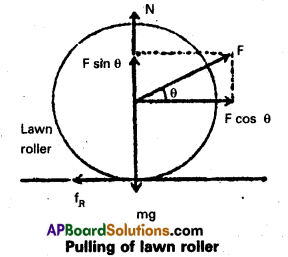
Let the force ‘F’ be resolved into two mutually perpendicular components F sin θ, vertically upwards and F cos θ horizontally along the road.
∴ The normal reaction N = mg – F sin θ
Then the frictional force acting towards left is FR = μRN, where μR is the coefficient of rolling friction between he roller and the road, or FR= μR (mg – F sin θ)
∴ The net pulling force on roller is P = F cos θ – FR = F cos θ – (μR mg – F sin θ)
or P = F(cos θ + μR sin θ) – μR mg ………………(1)

Pushing of lawn roller : When a lawn roller is pushed by a force ‘F1, which makes an angle ‘θ’ with the horizontal, the component of force acting vertically downwards is F sin θ. The horizontal component F cos θ pushes the roller to the right as shown in figure.
The weight ‘mg’ of the lawn roller acts vertically downwards. Therefore the normal reaction N of the surface on the roller
N = mg + F sin θ
Then the frictional force acting towards left.
FR = μRN = μR (mg + F sin θ)
The net pushing force on roller is
P’ = F cos θ – FR = F cos θ – μR (mg + F sin θ)
or P’ = F(cos θ – μR sin θ) – μR mg ……………… (2)
From equations (1) and (2) that it is easier to pull than push a lawn roller.
Long Answer Questions
Question 1.
a) State Newton’s second law of motion. Hence derive the equation of motion F = ma from it. [T.S. Mar. 18; A.P. Mar. 16, Mar. 13]
b) A body is moving along a circular path such that its speed always remains constant. Should there be a force acting on the body ?
Answer:
a) Newton’s Second of motion : “The rate of change of momentum of a body is directly proportional to the external force applied and takes place in the same direction”.
To show F = ma : Let a body of mass ‘m’ moving with a velocity ‘v’ under the action of an external force F in the direction of velocity.
Momentum ‘P’ of a body is the product of the mass and velocity V.
∴ P = mv ……………… (1)
According to Newton’s second law of motion, we have
\(\frac{\mathrm{dp}}{\mathrm{dx}}\) ∝ F, where F = external force
(or)F = K\(\frac{\mathrm{dp}}{\mathrm{dx}}\) ………………. (2)
From equations (1) and (2) we have
F = \(K \frac{d(m v)}{d t}=K \cdot m \frac{d v}{d t}\)
= Kma …………………. (3)
Since the rate of change of velocity \(\frac{\mathrm{dv}}{\mathrm{dx}}\) is the acceleration ‘a’ of the body.
In SI system the unit of force is Newton and is defined as that force which when acting on a body of mass 1 kg produces in it an acceleration of 1 ms-2.
i.e., from equation (3),
If F = 1, m = 1 and a = 1
we get K = 1
Hence F = \(\frac{\mathrm{dp}}{\mathrm{dx}}\) = ma .
∴ F = ma
b) Suppose a body is moving along a circular part though its speed always remains constant its velocity changes at every point and resultant force acts on the body.

Question 2.
a) Define angle of friction and angle of repose. Show that angle of friction is equal to angle of repose for a rough inclined place.
Answer:
Angle of friction : The angle of friction is defined as the angle made by the resultant of the normal reaction and the limiting friction with the normal reaction is called angle of friction.
Angle of repose : The angle of repose is defined as the angle of inclination of a plane with respect to horizontal for which the body will be in equilibrium on the inclined plane is called angle of repose.
Angle of friction is equal to angle of repose for a rough inclined plane : Let us consider a body of mass’m1 on a rough inclined plane. The angle of inclination of the rough surface is ‘θ’. By increasing the angle of inclination at one end, the body tends to slide on the surface. Then the angle of inclination ’0′ is called angle of repose.
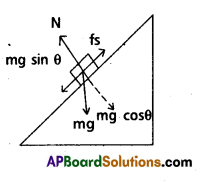
The weight (mg) of the body resolved into two components, the component mg cos 0 acts perpendicular to the inclined surface, which is equal to normal reaction ‘N‘.
i.e., N = mg cos θ ……………. (1)
The other component mg sin θ acts parallel to inclined plane and opposite to the frictional force ‘f’.
fs = my sin θ ……………… (2)
From \(\frac{(2)}{(1)} \Rightarrow \frac{f_s}{N}=\frac{m g \sin \theta}{m g{con} \theta}\)
= \(\frac{f_s}{N}\) = tan θ = µs
∴ µs = tan θ …………………. (3)
when ‘α’ is angle of friction then from the definition of co-efficient of static friction,
µs = tan α ………………… (4)
from (3) and (4)
⇒ tan θ = tan α
θ = α
Hence angle of friction is equal to angle of repose.
b) A block of mass 4 kg is resting on a rough horizontal plane and is about to move when a horizontal force of 30 N is applied on it. If g = 10 m/s2. Find the total contact force exerted by the plane on the block.
Solution:
Given m = 4kg
F = 30 N
g = 10 ms-2
a = \(\frac{F}{m}=\frac{30}{4}\) = 7.5 ms-2
µ = \(\frac{\mathrm{a}}{\mathrm{g}}=\frac{7.5}{10}=\frac{3}{4}\)
∴ Contact force = Frictional force
= µ mg
= \(\frac{3}{4}\) × 4 × 10 = 30 N.
Problems
Question 1.
The linear momentum of a particle as a function of time t is given by p = a + bt, where a and b are positive constants. What is the force acting on the particle ?
Answer:
Linear momentum of a particle p = a + bt
Force F = \(\frac{\mathrm{dp}}{\mathrm{dt}}\) = \(\frac{\mathrm{d}}{\mathrm{dt}}\)(a + bt) = 0 + b
∴ F = b

Question 2.
Calculate the time needed for a net force of 5 N to change the velocity of a 10 kg mass by 2 m/s.
Answer:
F = 5N, m = 10kg; (v-u) = 2m s-1, t = ?
F = \(m \frac{(v-u)}{t} \Rightarrow 5=\frac{10 \times 2}{t}\)
∴ t = 4s.
Question 3.
A ball of mass m is thrown vertically upward from the ground and reaches a height h before momentarily coming to rest. If g is acceleration due to gravity. What is the impulse received by the ball due to gravity force during its flight ? (neglect air resistance).
Answer:
mass = m
Initial velocity of a ball to reach h is,
u = \(\sqrt{2 g h}\)
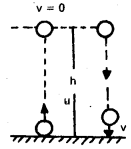
On return journey, velocity of a ball to reach the ground, v = –\(\sqrt{2 g h}\)
Impluse I = m (u – v) = m [\(\sqrt{2 g h}\) – (-\(\sqrt{2 g h}\))]
= m 2 \(\sqrt{2 g h}\) = 2m \(\sqrt{2 g h}\)
∴ I = \(\sqrt{8 m^2 g h}\)
Question 4.
A constant force acting on a body of mass 3.0 kg changes its speed from 2.0 in m s-1 to 3.5 m s-1 in 25 s. The direction of motion of the body remains unchanged. What is the magnitude and direction of the force ?
Answer:
m = 3.0 kg; u = 2.0 ms-1,
v = 3.5ms-1, t = 25 s;
F = m \(\left(\frac{v-u}{t}\right)\) = 3\(\left(\frac{3.5-2}{25}\right)\)
= \(\frac{3 \times 15}{25}=\frac{0.9}{5}\) = 0.18 N
This force acts in the direction of change in velocity.

Question 5.
A man in a lift feels an apparent weight W when the lift is moving up with a uniform acceleration of 1/3rd of the acceleration due to gravity. If the same man were in the same lift now moving down with a uniform acceleration that is 1/2 of the acceleration due to gravity, then what is his apparent weight ?
Answer:
When the lift is moving up, a = \(\frac{g}{3}\)
Apparent weight W = m(g + a)
= m(g + \(\frac{g}{3}\)) = \(\frac{4mg}{3}\)
⇒ mg = \(\frac{3 W}{4}\) …………….. (1)
When the lift is moving down, a = \(\frac{g}{2}\)
Apparent weight W1 = m(g – a)
= m(g – \(\frac{g}{2}\)) = \(\frac{mg}{2}\)
∴ |W1| = \(\frac{\left[\frac{3 W}{4}\right]}{2}=\frac{3 W}{8}\)
Question 6.
A container of mass 200 kg rests on the back of an open truck, if the truck accelerates at 1.5 m/s2, what is the minimum coefficient of static friction between the container and the bed of the truck required to prevent the container from sliding off the back of the truck ?
Answer:
m = 200kg, a = 1.5 ms-2, g = 9.8 ms-2
ma = μsmg
μs = \(\frac{a}{g}=\frac{1.5}{9.8}\) = 0.153
Question 7.
A bomb initially at rest at a height of 40 m above the ground suddenly explodes into two identical fragments. One of them starts moving vertically down- wards with an initial speed of 10 m/s. If acceleration due to gravity is 10 m/s2. What is the separa-tion between the fragments 2s after the explosion ?
Answer:
Bomb explodes into two fragments say 1 and 2.
For 1st fragment, u1 = 10m/s, t = 2 sec; g = 10 m/s-2, s1 = ?
Now displacement of 1st fragment,
s1 = u1t + \(\frac{1}{2}\) gt2
= 10 × 2 × \(\frac{1}{2}\) × 10 × 22 = 40m
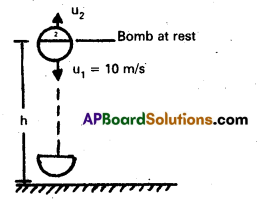
2nd fragment is move opposite to 1st fragment like an object from a tower.
For 2nd fragment u2 = – u1 = 10m/s
t = 2 sec; g = 10 m/s2
Now displacement of 2nd fragment
s2 = u2t + \(\frac{1}{2}\) gt2
= 10 × 2 × \(\frac{1}{2}\) × 10 × 22 = 0
∴ The seperation of two fragments
= s1 + s2 = 40 + 0 = 40 m

Question 8.
A fixed pulley with a smooth grove has a light string passing over it with a 4 kg attached on one side and a 3 kg on the other side. Another 3 kg is hung from the other 3 kg as shown with another light string. If the system is released from rest, find the common acceleration ? (g = 10 m/s2).
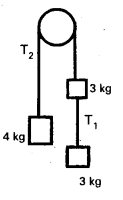
Answer:
From fig,
m1 = 3 + 3
= 6 kg
m2 = 4 kg
g = 10ms-2
Acceleration of the system,
a = \(\left(\frac{\dot{m}_1-m_2}{m_1+m_2}\right) g=\left(\frac{6-4}{6+4}\right) \times 10\) = 2 ms-2
Question 9.
A block of mass of 2 kg slides on an inclined plane that makes an angle of 30% with the horizontal. The coefficient of friction between the block and the surface is \(\frac{\sqrt{3}}{2}\).
(a) What force should be applied to the block so that it moves up without any acceleration ?
(b) What force should be applied to the block so that it moves up without any acceleration ?
Answer:
m = 2kg; θ = 30°; µ = \(\frac{\sqrt{3}}{2}\)
i) Fdown = mg (sinθ – µ cosθ)
= 2 × 9.8 (sin30° – \(\frac{\sqrt{3}}{2}\)cos30°)
= 2 × 98 [\(\frac{1}{2}\) – \(\frac{\sqrt{3}}{2}\) × \(\frac{\sqrt{3}}{2}\)] = 49 N
ii) Fup = mg (sinθ + µ cosθ)
= 2 × 9.8 [sin30° + \(\frac{\sqrt{3}}{2}\) × cos30°]
= 2 × 9.8 [\(\frac{1}{2}\) + \(\frac{\sqrt{3}}{2}\) × \(\frac{\sqrt{3}}{2}\)] = 24.5 N
Question 10.
A block is placed on a ramp of parabolic shape given by the equation g = \(\frac{x^2}{20}\), see If is = 0.5, what is the maximum height above the ground at which the block can be placed without slipping ? (tan θ = µs = \(\frac{\mathrm{d} y}{\mathrm{~d} x}\))
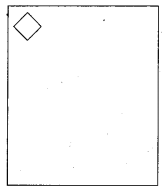
Answer:


Question 11.
A block of metal of mass 2 kg on a horizontal table is attached to a mass of 0.45 kg by a light string passing over a frictionless pulley at the edge of the table. The block is subjected to a horizontal force by allowing the 0.45 kg mass to fall. The coefficient of sliding friction between the block and table is 0.2.
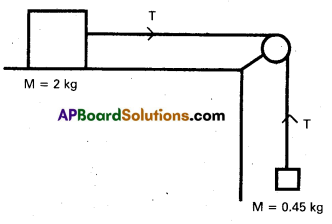
Calculate (a) the initial acceleration, (b) the tension in the string, (c) the distance the block would continue to move if. after 2 s of motion, the string should break.
Answer:
Here, m1 = 0.45kg
m2 = 2kg
µ = 0.2
a) Initial acceleration.
a = \(\left(\frac{m_1-\mu m_2}{m_1+m_2}\right) g=\left[\frac{0.45-0.2 \times 2}{0.45+2}\right] \times 9.8\)
a = 0.2ms-2
b) From fig, we have
T – f = m2 a
T – 3.92 = 2 × 0.2
[∵ f = µm2g = 0.2 × 2 × 9.8] = 3.92 N
⇒ N = 0.4 + 3.92 = 4.32 N
c) Velocity of string after 2 sec
= u in this case: µ’ = 0
Stoping distance s = \(\frac{\mu^2}{2 \mu g}=\frac{0.4 \times 0.4}{2 \times 0.2 \times 9.8}\) = 0.0408 m
Question 12.
On a smooth horizontal . surface a block A of mass 10 kg is kept. On this block a second block B of mass 5 kg is kept. The coefficient of friction between the two blocks is 0.4. A horizontal force of 30 N is applied on the lower block as shown.
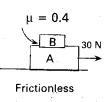
The force of friction between the blocks is (take g = 10 m/s2).
Answer:
Here mA = 10kg; mB = 5kg;
F = 30N; µ = 0.4
F = (mA + mB)a
⇒ a = \(\frac{F}{\left(m_A+m_B\right)}\)
= \(\frac{30}{10+5}\) = 2ms-2
f = mBa = 5 × 2 = 10 N
Additional Problems
(For simplicity in numerical calculations, take g = 10 ms-2)
Question 1.
Give the magnitude and direction of the net force acting on
a) a drop of rain falling down with a constant speed,
b) a cork of mass 10 g floating on water,
c) a kite skillfully held stationary in the sky,
d) a car moving with a constant velocity of 30 km/h on a rough road,
e) a high-speed electron in space far from all material objects and free of electric and magnetic fields.
Answer:
a) As the rain drop is falling with a constant speed, its acceleration a = 0. Hence net force F = ma = 0.
b) As the cork is floating on water, its weight is being balanced by the upthrust (equal-to weight of water displaced). Hence net force on the cork is zero.
c) As the kite is held stationary, net force on the kite is zero, in accordance with Newton’s first law.
d) Force is being applied to overcome the force of friction. But as velocity of the car is constant, its acceleration, a = 0. Hence net force on the car F = ma = 0.
e) As no field (gravitational / electric / magnetic) is acting on the electron, net force on it is zero.

Question 2.
A pebble of mass 0.05 kg is thrown vertically upwards. Give the direction and magnitude of the net force on the pebble.
a) during its upward motion,
b) during its downward motion
c) at the highest point where it is momentarily at rest. Do your answers change if the pebble was thrown at ah angle of 45° with the horizontal direction ?
Ignore are resistance.
Answer:
When a body is thrown vertically upwards (or) it moves vertically downwards, gravitational pull of earth gives it a uniform acceleration a = + g = + 9.8 ms-2 in the downward direction. Therefore, the net force on the pebble in all the three cases is vertically downwards.
As m = 0.05 kg and a = + 9.8 m/s2
In all the three cases,
∴ F = ma
= 0.05 × 9.8 = 0.49 N, vertically downwards.
If the pebble were thrown at an angle of 45° with the horizontal direction, it will have horizontal and vertical components of velocity. These components do not affect the force on the pebble. Hence our answers do not alter in any case. However in each case (C), the pebble will not be at rest. It will have horizontal component of velocity at highest point.
Question 3.
Give the magnitude and direction of the net force acting on a stone of mass 0.1 kg.
a) just after it is dropped from the window of stationary train,
b) just after it is dropped from the window of a train running at a constant velocity of 36 km/h,
c) just after it is dropped from the window of a train accelerating with 1 ms-2,
d) lying on the floor of a train which is accelerating with 1 ms-2, the stone being at rest relative to the train.
Answer:
a) Here, m – 0.1 kg, a = +g = 9.8 m/s2
Net force, F = ma = 0.1 × 9.8 = 0.98 N This force acts vertically downwards.
b) When the train is running at a constant velocity its acc. = 0. No force acts on the stone due to this motion.
Therefore, force on the stone F = weight of stone mg = 0.1 × 9.8 = 0.98 N
This force also acts vertically downwards.
c) When the train is accelerating with 1m/s2, an additional force F1 = ma = 0.1 × 1 = 0.1 N acts on the stone in the horizontal direction. But once the stone is dropped from the train, F1 becomes zero and the net force on the stone is F = mg = 0.1 × 9.8 = 0.98 N, acting vertically downwards.
d) As the stone is lying on the horizontal direction of motion of the train. Note the weight of the stone in this case is being balanced by the normal reaction.
Question 4.
One end of a string of length l is connected to a particle of mass m and the other to a small peg on a smooth horizontal table. If the particle moves in a circle with speed v the net force on the particle (directed towards the centre) is ;
i) T,
ii) T – \(\frac{\mathrm{m} v^2}{l}\),
iii) T + \(\frac{\mathrm{m} v^2}{l}\),
iv) 0
T is the tension in the string. (Choose the correct Answer)
Answer:
The net force on the particle directed towards the center is T. This provides the necessary centripetal force to the particle moving in the circle.

Question 5.
A constant retarding force of 50 N is applied to a body of mass 20 kg moving initially with a speed of 15 ms-1. How long does the body take to stop ?
Answer:
Here, F = -50 N, m = 20 kg
μ = 15 m/s, v = 0, t = ?
From F = ma,
a = \(\frac{F}{m}=\frac{-50}{20}\) = -2.5 m/s2
From v = u + at
0 = 15 – 2.5t
t = \(\frac{15}{2.5}\) = 6s.
Question 6.
A constant force acting on a body of mass 3.0 kg changes its speed from 2.0 ms-1 to 3.5 ms-1 in 25 s. The direction of the motion of the body remains unchanged. What is the magnitude and direction of the force ?
Answer:
Here m = 3.0 kg
μ = 2.0 m/s
v = 3.5 m/s,
t = 25s, F = ?
F = ma = \(\frac{m(v-u)}{t}=\frac{3.0(3.5-2.0)}{25}\)
= 0.18 N.
The force is along the direction of motion.
Question 7.
A body of mass 5 kg is acted upon by two perpendicular forces 8 N and 6 N. Give the magnitude and direction of the acceleration of the body ?
Answer:
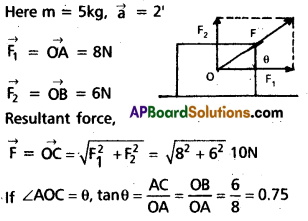
θ = 36° 52
This the direction of resultant force and hence the direction of acceleration of the body, fig.
Also a = \(\frac{F}{m}=\frac{10}{5}\) = 2ms-2
Question 8.
The driver of a three-wheeler moving with a speed of 36 km/h sees a child standing in the middle of the road and brings his vehicle to rest in 4.0 s just in time to save the child. What is the average retarding force on the vehicle ? The mass of the three wheeler is 400 kg and the mass of the driver is 65 kg.
Answer:
Here, u = 36km/h = 10 m/s, v = 0, t = s
m = 400 + 65 = 465 kg
Retarding force
F = ma = \(\frac{m(v-u)}{t}=\frac{465(0-10)}{4}\) = -1162 N.

Question 9.
A rocket with a lift-off mass 20,000 kg is blasted upwards with an initial acceleration of 5.0 ms-2. Calculate the initial thrust (force) of the blast.
Answer:
Here m = 20,000 kg = 2 × 104 kg
Initial ace = 5 m/s2
Thrust, F = ?
Clearly, the thrust should be such that it overcomes the force of gravity besides giving it an upward acceleration of 5 m/s2. Thus the force should produce a net acceleration of 9.8 + 5.0 = 14.8 m/s2 As thrust = force = mass × acceleration
∴ F = 2 × 104 × 14.8 = 2.96 × 105N
Question 10.
A body of mass 0.40 kg moving initially with a constant speed of 10 ms-1 to the north is subject to a constant force of 8.0 N directed towards the south for 30 s. Take the instant the force is applied to be t = 0, the position of the body at the time to be x = 0 and predict its position at t = -5 s, 25 s, 100 s.
Answer:
Here, m = 0.40 kg, µ = 10m/s due N
F = – 8.0 N
a = \(\frac{F}{m}=\frac{-8.0}{0.40}\) = -20 m/s2
for 0 ≤ t ≤ 30s.
i) At t = -5s, x = Ut = 10 × (-5) = -50 m
ii) At t = 25s, x = Ut + \(\frac{1}{2}\) at2
= 10 × 25 + \(\frac{1}{2}\) (-20) (25)2 = – 6000m
iii) At t = 100s, The problem is divided into two parts, upto 30s, there is force/acc.
∴ from x1 = Ut + \(\frac{1}{2}\) at2
= 10 × 30 + \(\frac{1}{2}\) (-20) (30)2
= -8700
At t = 30s, v = U + at = 10 – 20 × 30 = – 590 m/s,
∴ for motion from 30s to 100s
x2 = vt = – 590 × 70 = – 41300 m
x = x1 + x2 = -8700 – 41300
= -50,000 m = – 50km.
Question 11.
A truck starts from rest and accelerates uniformly at 2.0 ms-2. At t = 10 s, a stone is dropped by a person standing on the top of the truck (6 m high from the ground). What are the (a) velocity and (b) acceleration of the stone at t = 11 s ? (Neglect air resistance).
Answer:
Here, u = 0, a = 2 m/s2, t = 10s

Let v be the velocity of the truck when the stone is dropped.
From v = u + at
v = 0 + 2 × 10 = 20m/s
a) Horizontal velocity of stone, when it is dropped, vx = v = 20 m/s.
As air Resistance is neglected, vx remains constant.
In the vertical direction, initial velocity of stone, µ = 0, a = g = 9.8 m/s2,
time t = 11 – 10 = 1s
From v = u + at
vy = 0 + 9.8 × 1 = 9.8 ms-1
Resultant velocity of stone, OC is given by
v = \(\sqrt{v_x^2+v_y^2}=\sqrt{20^2+(9.8)^2}\)
v = 22.3 m/s.
Let θ is the angle with the resultant velocity OC of stone makes with the horizontal direction OA, then from fig.
tan θ = \(\frac{v_y}{v_x}=\frac{9.8}{20}\) = 0.49
∴ θ = 29°
b) The moment the stone is dropped from the car, horizontal force on the stone = 0. The only acceleration the path followed by the stone is, however parabolic.

Question 12.
A bob of mass 0.1 kg hung from the ceiling of a room by a string 2 m long is set into oscillation. The speed of the bob at its mean position is 1 ms-1. What is the trajectory of the bob if the string is cut when the bob is (a) at one of its extreme positions, (b) at its mean position.
Answer:
a) We shall study in unit x that at each extreme position, velocity of the bob is zero. If the string is cut at the extreme position, it is only under the action of ‘g’. Hence the bob will fall vertically downwards.
b) At the mean position, velocity of the bob is 1m/s. along the tangent to the arc, which is in the horizontal direction. If the string is let at mean position, the bob will be have as a horizontal projectile. Hence it will follow a parabolic path.
Question 13.
A man of mass 70 kg stands on a weighing scale in a lift which is moving
a) upwards with a uniform speed of 10 ms-1
b) downwards with a uniform acceleration of 5 ms-2
c) upwards with a uniform acceleration of 5 ms-2
What would be the readings on the scale in each case ?
d) What would be the reading if the lift mechanism failed and it hurtled down freely under gravity ?
Answer:
Here, m = 70 kg, g = 9.8 m/s2
The weighing machine in each case measures the reaction R i.e. the apparent weight.
a) When lift moves upwards with a uniform speed, its accelerations is zero.
R = mg = 70 × 9.8 = 686N
b) When the lift moves downwards with a = 5 m/s2
R = m(g – a) = 70 (9.8 – 5) = 336 N
c) When the lift moves upwards with a = 5 m/s2
R = m(g + a) = 70 (9.8 + 5) = 1036 N
If the lift were to come down freely under gravity, downward acc. a = g
∴ R = m (g – a) = m(g – g) = zero
Question 14.
Figure shows the position-time graph of a particle of mass 4 kg. What is the (a) force on the particle for t < 0, t < 4 s, 0 < t < 4s ? (b) impulse at t = 0 and t = 4 s ?
(Consider one-dimensional motion only)
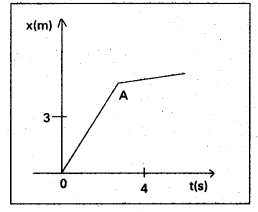
Answer:
i) For t < 0, the position time graph is OA which means displacement of the particle is zero.
i.e. particle is at rest at the origin. Hence force on the particle must be zero.
ii) For 0 < t < 4s, s, the position time graph OB has a constant slope. Therefore, velocity of the particle is constant in this interval i.e. particle has zero acceleration. Hence force on the particle must be zero. iii) For t > 4s, the position time graph BC is parallel to time axis. Therefore, the particle remains at a distance 3m from the origin, i.e. it is at rest. Hence force on the particle is zero.
iv) Impulse at t = 0 :
We know. Impulse = change in linear momentum, Before t = 0 particle is at rest i.e. u = 0. After t = 0, particle has a constant velocity v = \(\frac{3}{4}\)
= 0.75 m/s
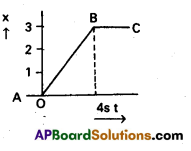
∴ Impulse = m(v – u)
= u (0.75-0)
= 3kg m/s
∴ Impulse at t = 4s
Before t = 4s, particle has a constant velocity u = 0.75 m/s
After t = 4s, particle is at rest i.e. v = 0
Impulse = m(v – u) = 4 (0 – 0.75) = 3kg m/s.

Question 15.
Two bodies of masses 10 kg and 20 kg respectively kept on a smooth, horizontal surface are tied to the ends of a light string, a horizontal force F = 600 N is applied to (i) A, (ii) B along the direction of String. What is the tension in the string in each case ?
Answer:
Here, F = 500 N
m1 = 10kg, m2 = 20kg
Let T be the tension in the string and a be the acceleration of the system, in the direction of the force applied.
a = \(\frac{F}{m_1+m_2}=\frac{500}{10+20}=\frac{50}{3}\) m/s2
a) When force is applied on heavier block,
T = m1 a = 10 × \(\frac{50}{3}\) N
T = 166.66 N
b) When force is applied on lighter block,
T = m2a = 20 × \(\frac{50}{3}\) N
= 333.33 N
Which is different from value T in case (a) Hence our answer depends on which mass end, the force is applied.
Question 16.
Two masses 8 kg and 12 kg are connected at the two ends of a light inextensible string that goes over a frictionless pulley. Find the acceleration of the masses, and the tension in the string when the masses are released.
Answer:
Here, m2 = 8 kg, m1 = 12kg
as a = \(\frac{\left(m_1-m_2\right) g}{m_1+m_2}\)
a = \(\frac{(12-8) 9.8}{12+8}=\frac{39.2}{20}\)
= 1.96 m/s2
Again
T = \(\frac{2 m_1 m_2 g}{m_1+m_2}=\frac{2 \times 12 \times 8 \times 9.8}{(12+8)}\) = 94.1 N
Question 17.
A nucleus is at rest in the laboratory frame of reference. Show that if it disintegrates into two smaller nuclei the products must move in opposite directions.
Answer:
Let m1m2 be the masses of products and \(\vec{v}_1, \vec{v}_2\) be their respective velocities. Therefore total linear momentum after disintegration = \(m_1 \overrightarrow{v_1}+m_2 \overrightarrow{v_2}\). Before disintegration, the nucleus is at rest. There, its linear momentum before dis-integration is zero. According to the principle of conservation of linear momentum.
\(m_1 \overrightarrow{v_1}+m_2 \overrightarrow{v_2}\) (Or) \(\vec{v}_2=\frac{-m_1 \vec{v}_1}{m_2}\)
Negative sign shows that \(\overrightarrow{v_1}\) and \(\overrightarrow{v_2}\) are in opposite direction.
Question 18.
Two billiard balls each of mass 0.05 kg moving in opposite directions with speed 6 ms-1 collide and rebound with the same speed. What is the impulse imparted to each ball due to the other ?
Answer:
Here, initial momentum of the ball,
A = 0.05 (6) = 0.3 kg m/s
As the speed is reversed on collision, final momentum of the ball A = 0.05 (-6)
= – 0.3 kg ms-1
Impulse imparted to ball A = Change in momentum of ball A = Final momentum – Intial momentum = – 0.3 – 0.3 = – 0.6 kg m/s

Question 19.
A shell of mass 0.020 kg is fired by a gun of mass 100 kg. If the muzzle speed of the shell is 80 ms-1, what is the recoil speed of the gun ?
Answer:
Here, mass of shell m = 0.02 kg
Mass of gun M = 100 kg
Muzzle speed of shell v = 80 m/s
Recoil speed of gun V = ?
According to the principle of conservation of linear momentum mv + MV = 0
(Or) V = \(\frac{-\mathrm{mv}}{\mathrm{M}}=\frac{-0.02 \times 80}{100}\) = 0.016 m/s
Question 20.
A batsman deflects a ball by the angle of 45° without changing its initial speed which is equal to 54 km/h. What is the impulse imparted to the ball ? (Mass of the balls is 0.15 kg).
Answer:
In fig. the ball hits the bat KL along AO and is deflected by the bat along OB. Where LAOB = 45°. ON is normal to the portion of the bat KL deflecting the ball.
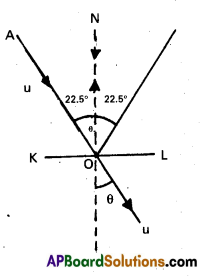
∴ θ = LNOA
= 45°/2 = 22.5°
Intial vel along AO = u = 54 km/h
= 15 m/S1 and mass of ball m = 0.15 kg Intial velocity along AO has the two rectangular components : u cos θ along NO produced and u sin 6 along the horizontal OL.
Final velocity along OB has the same magnitude = u
It is resolved into two rectangular components u cos 6 along ON and u sin θ along OL. We observe that there is no change in velocity along the horizontal, but velocity along vertical is just reserved.
∴ Impulse imparted to the ball
= Change in linear momentum of the ball
= m u cos θ – (- m u cos θ)
= 2 m u cos θ
= 2 × 0.15 × 15 cos 22.5°
= 4.5 × 0.9239
= 4.16 kg m/s
Question 21.
A stone of mass 0.25 kg tied to the end of a string is whirled round in a circle of radius 1.5 m with a speed of 40 rev./ min in a horizontal plane. What is the tension in the string ? What is the maximum speed with which the stone can be whirled around if the string can withstand a maximum tension of 200 N?
Answer:
Here, m = 0.25 kg, r = 15m
n = 40 rpm = \(\frac{40}{60}\), rps = \(\frac{2}{3}\), T = ?
T = mrw2 = mr(2 π)2 = 4 π2m2
T = 4 × \(\left(\frac{22}{7}\right)^2\) × 0.25 × 1.5 × \(\left(\frac{2}{3}\right)^2\) = 6.6N
If Tmax = 200 N. then from
Tmax = \(\frac{\mathrm{mv}_{\max }^2}{r}\)
\(v_{\max }^2=\frac{T_{\max } \times r}{m}=\frac{200 \times 1.5}{0.25}\) = 1200
vmax = \(\sqrt{1200}\) = 34.6 m/s

Question 22.
If, in Exercise 5.21, the speed of the stone is increased beyond the maximum permissible value, and the string breaks suddenly, which of the following correctly describes the trajectory of the stone after the string breaks :
a) the stone moves radially outwards,
b) the stone flies off tangentially from the instant the string breaks,
c) the stone flies off at an angle with the tangent whose magnitude depends on the speed of the particle ?
Answer:
The instant the string, breaks, the stone flies off tangentialy, as per Newton’s first law of motion.
Question 23.
Explain why
a) a horse cannot pull a cart and run in empty space,
b) passengers are thrown forward from their seats when a speeding bus stops suddenly,
c) it is easier to pull a lawn mower than to push it.
d) a cricketer moves his hands back-wards while holding a catch.
Answer:
a) While trying to pull a cart, a horses pushes the ground backwards with a certain force at an angle. The ground offers an equal reaction in the opposite direction on the feet of the horse. The forward component of this reaction is responsible for the motion of the cart. In empty space, there is no reaction and hence a horse cannot pull the cart and run.
b) This is due to inertia of motion. When the speeding bus stops suddenly, lower part of the body in contact with the seats stops. The upper part of the body of the passengers tend to maintain its uniform motion. Hence the passengers are thrown forward.
c) While pulling a lawn roller, force is applied upwards along the handle. The vertical component of this force is upwards and reduces the effective weight of the roller, fig. (a) while pushing a lawn roller. Face is applied downwards along the handle. The vertical component of this force is downwards and increases the effective weight of the roller, fig. (b). As the effective weight is lesser in case of pulling than in a case of pushing, therefore pulling is easier than pushing.
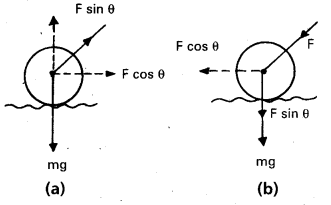
d) While holding a catch, the impulse receives by the hands F × t = Change in linear momentum of the ball is constant. By moving his hands, backwards, the cricketer increases the time of impact (t) to complete the catch. As t increases, F decreases and as a reaction, his hands are not hurt severly.
Question 24.
Figure shows the position-time graph of a body of mass 0.04 kg. Suggest a suitable physical context for this motion. What is the time between two consecutive impulses received by the body ? What is the magnitude of. each impulse ?
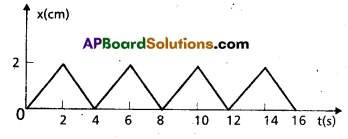
Answer:
Here, m = 0.04 kg. position time graph shows that the particle moves from x = 0 at 0 to x = 2 cm at A in 2 sec.
As x – t graph is a st. line, the motion is with a constant velocity.
μ = \(\frac{(2-0) \mathrm{cm}}{(2-0) \mathrm{s}}\) = 1 cm s-1
= 10-2 ms-1
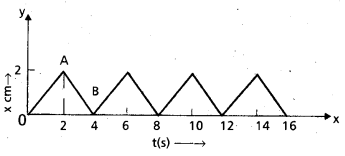
From x = 2 cm at A, particle goes to x = 0 at B in 2 sec.
As AB is a stline, motion is with constant velocity v = 1 cm/s = 10-2 m/s
Negative sign indicates the reversal of direction of motion. This is being repeated. We can visualise a ball moving between two walls located at x = 0 and x = 2 cm, getting rebounded repeatedly on striking against each wall on every collision with a wall, linear momentum of the ball changes. Therefore, the ball receives impulse after every two seconds. Magnitude of impulse = Total change in linear momentum.
= mu -(mv) = mu – mv = m(u – v)
= 0.04(10-2 + 10-2)
= 0.08 × 10-2
= 8 × 10-4 kg m/s

Question 25.
Figure shows a man standing stationary with respect to a horizontal conveyor belt that is accelerating with 1 ms-2. What is the net force on the man ? If the coefficient of static friction between the man’s shoes and the belt is 0.2, up to what acceleration of the belt can the man continue to be stationary relative to the belt ? (Mass of the man = 65 kg).

Answer:
Here, acceleration of conveyer belt, a = 1 m/s2
As the man is standing stationary w.r.t the belt, acceleration of the man = Acceleration of belt = a = 1 m/s2
As m = 65 kg
∴ Net force on the man, F = ma = 65 × 1 = 65 N
Now, µ = 0.2
Force of limiting friction- F = µR = µmg
It the man remains stationary upto max.acc. a of the belt, then F = ma1 = g mg
a1 = mg = 0.2 × 9.8 = 1.96 ms-2
Question 26.
A stone of mass m tied to the end of a string revolves in a vertical circle of radius R. The net forces at the lowest and highest points of the circle directed vertically downwards are : (Choose the correct alternative)
Lowest Point – Highest Point
a) mg – T1 – mg + T2
b) mg + T1 – mg – T2
c) mg + T1 – (mυ12)/R – mg – T2 + (mυ12)/R
d) mg – T1 – (mυ12/R – mg + T2 + (mυ12)/R
T1 and υ1 denote the tension and speed at the lowest point T2 and υ2 denote corresponding values at the highest point.
Answer:
The net force at the lowest point α is
FL = (mg – T1) and the net force at the highest point H is FH = mg + T2. Therefore, alternative (a) is correct.
Question 27.
A helicopter of mass 1000 kg rises with a vertical acceleration of 15 ms-2. The crew and the passengers weight 300 kg. Give the magnitude and direction of the
a) force on the floor by the crew and passengers,
b) action of the rotor of the helicopter on the surrounding air,
c) force on the helicopter due to the surrounding air.
Answer:
Here, mass of the helicopter, m1 = 100 kg
Mass of the crew and passengers m2 = 300 kg
Upward acceleration a = 15 ms-2 and g = 10 ms-2
a) Force on the floor of helicopter by the crew and passengers = appeard weight of crew and passengers = m2(g + a)
= 300(10 + 15) = 7500 N
b) Action of rotor of helicopter on surrounding air is obviously vertically downwards because helicopter rises on account reaction to this force. Thus, force of action F = (m1 + m2) (g + a)
= (1000 + 300) (10 + 15)
= 1300 × 25 = 32500 N
c) Force on the helicopter due to surrounding air is the reaction. As action and reaction are equal and opposite, therefore, force of reaction F1 = 32500 N, vertically upwards.

Question 28.
A stream of water flowing horizontally with a speed of 15 ms-1 gushes out of a tube of cross-sectional area 10-2m2 and hits a vertical wall nearby. What is the force exerted on the wall by the impact of water, assuming it does not rebound ?
Answer:
Here v = 15 ms-1
Area of cross section a = 102 m-2, F = ?
Volume of water pushing out/sec
= a × v = 10-12 × m3 s-1
As density of water is 103 kg/m2, therefore, mass of water striking the wall per sec.
m = (15 × 10-2) × 103 = 150 kg/s
Change in linear momentum
As F = \(\frac{\text { Change in linear momentum }}{\text { Time }}\)
∴ F = \(\frac{m \times v}{t}=\frac{150 \times 15}{1}\) = 2250 N
Question 29.
Ten one-rupee coins are put on top of each other on a table. Each coin has a mass m. Give the magnitude and direction of
a) the force on the 7th coin (counted from the bottom) due to all the coins on its top
b) the force on the 7th coin by the eighth coin,
c) the reaction of the 6th coin on the 7th coin.
Answer:
a) The force on 7th coin is due to weight of the three coins lying above it. Therefore,
F (3m) kgf = (3mg)N
Where g is acceleration due to gravity. This force acts vertically downwards.
b) The eighth coin is already under the weight of two coins above it and it has its own weight too. Hence force on 7th coin due to 8th coin is sum of the two forces i.e.,
F = 2m + m = 3(m) kgf = (3mg)N
The force acts vertically downwards.
c) The sixth coin is under the weight of four coins above it.
Reaction, R = – F = -4m(kgf) = -(4 mg)N
Minor sign indicates that the reaction acts vertically upwards, opposite to the weight.
Question 30.
An aircraft executes a horizontal loop at a speed of 720 km/h with its wings banked at 15°. What is the radius of the loop ?
Answer:
Here θ = 15°
v = 720 km/h =\(\frac{720 \times 1000}{60 \times 60}\) = 200 ms-1
g = 9.8 ms-2
From tan θ = \(\frac{\mathrm{v}^2}{\mathrm{rg}}\)
v2 = rg tan θ
r = \(\frac{v^2}{g \tan \theta}=\frac{(200)^2}{9.8 \times \tan 15^{\circ}}\)
= 15232 m = 15.232 km

Question 31.
A train runs along an unbanked circular track of radius 30 m at a speed of 54 km/h. The mass of the train is 106 kg. What provides the centripetal force required for this purpose – The engine or the rails ? What is the angle of banking required to prevent wearing out of the rail ?
Answer:
The centripetal force is provided by the lateral thrust exerted by the rails on the wheels. By Newton’s 3rd law, the train exerts an equal and opposite thrust on the rails causing its wear and tear.
Obviously, the outer rail will wear out faster due to the larger force exerted by the train on it.
Here v = 54 km/h =\(\frac{54 \times 1000}{60 \times 60}\) = 15 m/s
g = 9.8 ms-2
As tan θ = \(\frac{v^2}{r g}=\frac{15 \times 15}{30 \times 9.8}\) = 0.76
∴ θ = tan-1 0.76 = 37.4°
Question 32.
A block of mass 25 kg is raised by a 50 kg man in two different ways as shown in Fig. What is the action on the floor by the man in the two cases ? If the floor yields to a normal force of 700 N, which mode should the man adopt to lift the block without the floor yielding ?

Answer:
Here, mass of block m = 25 kg
Mass of man M = 50 kg
Force applied to lift the block
F = mg = 25 × 9.8 = 245 N
Weight of Man W = mg = 50 × 9.8 = 490 N
a) When block is raised by man as shown in Fig. force is applied by the man in the upward direction. This increases the apparent weight of the man. Hence action on the floor.
W1 = W + F
= 490 + 245
= 735 N
b) When block is raised by man as shown in Fig. force is app ed by the man in the downward direction. This decreases the apparent weight of the man. Hence action on the floor in this case would be
W1 = W – F = 490 – 245 = 245 N
As the floor yeilds to a normal force of 700 N, the mode (b) has to be adopted by the man to lift the block
Question 33.
A monkey of mass 40 kg climbs on a rope (Fig.) which can stand a maximum tension of 600 N. In which of the following cases will the rope break : the money
a) climbs up with an acceleration of 6 m s-2
b) climbs down with an acceleration of 4 ms-2
c) climbs up with a uniform speed of 5 ms-1
d) falls down the rope nearly freely under gravity ?
(ignore the mass of the rope)
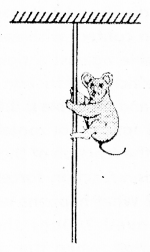
Answer:
Here, mass of monkey m = 40 kg
Maximum tension the rope can stand T = 600 N
In each case, actual tension in the rope will be equal to apparent weight of money (R). The rope will break when R exceeds T.
a) When monkey climbs up with a = 6 ms-2
R = m(g + a)
= 40(10 + 6)
= 640 N (Which is greater than T)
Hence the rope will break.
b) When monkey climbs down with a = 4 ms-2,
R = m(g – a) = 40(10 – 4) = 240 N
Which is less than T.
∴ The rope will not break.
c) When monkey climbs up with a uniform speed v = 5 ms-1.
Its acceleration, a = 0
∴ R = mg = 40 × 10 = 400 N,
which is less than T.
∴ The role will not break
d) When monkey falls down the rope nearly freely under gravity
a = g
∴ R = m(g – a) = m(g – g) = zero
Hence the rope will not break.

Question 34.
Two bodies A and B of masses 5 kg and 10 kg in contact with each other rest on a table against a rigid wall (Fig.). The coefficient of friction between the bodies and the table is 0.15. A force of 200 N is applied horizontally to A. What are (a) the reaction of the partition (b) the action-reaction forces between A and B ? What happens when the wall is removed ? Does the answer to (b) change, when the bodies are in motion? Ignore the difference between μs and μk.
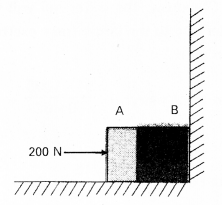
Answer:
Here, mass of body A, m1 = 5 kg
Mass of body B, m2 = 10 kg
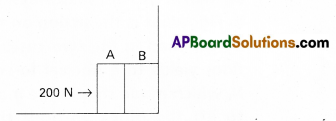
Coefficient of friction between the bodies and the table, μ = 0.15
Horizontal force applied on A,
F = 200 N
a) Force of limiting friction acting to the left
f = μ (m1 + m2)g
= 0.15(5 + 10) × 9.8 = 22.05 N
∴ Net force to the right exerted on the partition
F’ = 200 – 22.05 = 177.95 N
Reaction of partition = 177.95 N to the left.
b) Force of limiting friction acting on body A
f1 = μm1g = 0.15 × 5 × 9.8
= 7.35 N
∴ Net force exerted by body A on body B.
F” = F -f1 = 200 – 7.35
= 19265 N
This is to the right
Reaction of body B on body A = 192.65
N to the left when the portion is removed, the system of two bodies will move under the action of net force.
F1 = 177.95 IM
Acceralation produced in the system
a = \(\frac{F^1}{m_1+m_2}=\frac{177.95}{5+10}\)
= 11.86 ms-2
Force producing motion in body A
F1 = m1 a = 5 × 11.86
= 59.3 N
∴ Net force exerted by A on body B, when partition is removed
= F” – F1 = 192.65 – 59.3
= 133.35 N.
Hence the reaction of body B on A, when partition is removed = 133.35 N to the left.
Thus answers to (b) do change.
Question 35.
A block of mass 15 kg is placed on a long trolley. The cofficient of static friction between the block and the trolley is 0.18. The trolley accelerates from rest with 0.5 ms-2 for 20 s and then moves with uniform velocity. Discuss the motion of the block as viewed by (a) a stationary observer on the ground, (b) an observer moving with the trolley.
Answer:
a) Flere, m = 15 kg;
μ = 0.18,
a = 0.5 ms-2
t = 20 s

Force on the block due to motion of the trolly F’ = ma = 15 × 0.5 = 7.5 N
Force of limiting friction on the block
= F = μR = μmg
= 0.18 × 15 × 9.8 = 26.46 N
This opposes the motion of the block. The block shall not move. The force of static friction F will adjust itself equal and opposite to F’, the applied force.
Flence to a stationary observer on the ground, the block will appear to be at rest relative to the trolly. When trolly moves with uniform velocity, the block will continue to be stationary. Because in that case, forward force is zero. Force of friction alone is acting on the block.
b) An observer moving with the trolly has accelerated motion. The observer is therefore non-inertial.. The law of inertia is no longer valid.

Question 36.
The rear side of a truck is open and a box of 40 kg mass is placed 5 m away from the open end as shown in Fig. The coefficient of friction between the box and the surface below it is 0.15. On a straight road, the truck starts from rest and accelerates with 2 ms-2. At what distance from the starting point does the box fall of the truck?
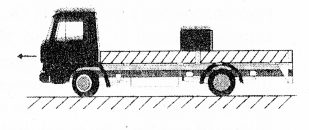
Answer:
Here mass of the box m = 40 kg
Acceleration of truck a = 2 ms-2
Distance of box from open end S = 5m
Coeff. of friction μ = 0.15
Force on the box due to accelarated motion of the truck, F = ma = 40 × 2 = 80 N
This force F is in the forward direction Reaction F’ on the box is equal to F = 80 N in the backward direction. This is opposed by force of limiting friction
f = μ R = μ mg
= 0.15 × 40 × 9.8
= 58.8 N in the forward direction
∴ Net force on the box in the backward direction is p = F’ – F = 80 – 58.8 = 21.2 N
Backward acceleration produced in the box
a = \(\frac{p}{m}=\frac{21.2}{40}\) = 0.53 ms-2
It t is time taken by the box to travel S = 5 metre and fall off the truck, then from
S = ut + \(\frac{1}{2}\) at2
5 = 0 × t + \(\frac{1}{2}\) × 0.53 t2
t = \(\frac{\sqrt{5 \times 2}}{0.53}\) = 4.345
If the truck travels a distance x during this time, then again from
S = ut + \(\frac{1}{2}\) at2
x = 0 × 4.34 + \(\frac{1}{2}\) × 2(4.34)2 = 18.84 m
Question 37.
A disc revolves with a speed of 33\(\frac{1}{3}\) rev/min, and has a radius of 15 cm. Two coins are placed at 4 cm and 14 cm away from the centre of the record. If the co-efficient of friction between the coins and the record is 0.15, which of the coins will revolve with the record ?
Answer:
The coin revolves with the record in the case when the force of friction is enough to provide the necessary centripetal force. If this force is not sufficient to provide centripetal force, the coin slips on the record.
Now the frictional force is µR where R is the
normal reaction and R = mg
Hence force of friction = µ mg and centripetal force required is \(\frac{m v^2}{r}\) or mrw2
µ1w are same for both the coins and we have different values of r for the two coins.
So to prevent slipping i.e., causing coins to rotate µ mg > mrω2 or µg > rω2 …………….. (1)
For 1st coin
r = 4 cm = \(\frac{4}{100}\) m
n = 33 \(\frac{1}{2}\) rev/min = \(\frac{100}{3 \times 60}\) rev/sec
w = 2πn = 2π × \(\frac{100}{180}\) = 3.49 S-1
∴ rw2 = \(\frac{4}{100}\) × (3.49)2 = 0.49 ms-2 and
µg = 0.15 × 9.8 = 1.47 ms-2
As µg > rw2, there fore this coin Will revolve with the record.
Note: We have nothing to do with the radius of the record = 15 cm

Question 38.
You may have seen in a circus a motor-cyclist driving in verticle loops inside a ‘death-well’ (a hollow spherical chamber with holes, so the spectators can watch from outside). Explain clearly why the motorcyclist does not drop down when he is at the uppermost point, with no support from below. What is the minimum speed required at the uppermost position to perform a verticle loop if the radius of the chamber is 25 m ?
Answer:
At the uppermost point of the death well, with no support from below, the motorcyclist does not drop down. This is because his weight is being balance by the centrifugal force. Infact, the weight of the motorcyclist is spent up in providing the necessary centripetal force to the motorcyclist and hence he does not drop drown.
At the uppermost point, R + mg = \(\frac{m v^2}{r}\),
where R is the normal reaction (downwards) on the motor cyclist by the ceiling of the chamber.
Speed will be minimum, when N = 0
∴ mg = \(\frac{m v^2}{r}\) or
v = \(\sqrt{\mathrm{rg}}=\sqrt{25 \times 10}\)
= 15.8 m/s
Question 39.
A 70 kg man stands in contact against the inner wall of a hollow cylindrical drum of radius 3 m rotating about its vertical axis with 200 rev/min. The coefficient of friction between the wall and his clothing is 0.15. What is the minimum rotational speed of the cylinder to enable the man to remain stuck to the wall (without falling) when the floor is suddenly removed ?
Answer:
Here m = 70 kg, r = 3
n = 200 rpm = \(\frac{200}{60}\) rps
µ = 0.15
w = ?
The horizontal force N by the wall on the man provides the necessary centripetal force = mrω2. The frictional force (f) in this case is vertically upwards opposing the weight (mg) of the man.
After the floor is removed, the man will remain stuck to the wall, when
mg = f < µ N i.e., mg < µ mr ω2 or g < µ r ω2
∴ Minimum angular speed of rotation of the cylinder is ω = \(\sqrt{\frac{g}{\mu \mathrm{r}}}=\sqrt{\frac{10}{0.15 \times 3}}\)
= 4.7 rad/s
Question 40.
A thin circular loop of radius R rotates about its vertical diameter with an angular frequency no. Show that a small bead on the wire loop remains at its
lowermost point for ω ≤ \(\sqrt{g / R}\) . What is the angle made by the radius vector joining the centre to the bead with the vertical downward direction for ω = 2g/R ?
Answer:
In fig. we have show that radius vector joining the bead to the centre of the wire makes as angle θ with the vertical downward direction. It N is normal reaction, then as it is clear from the figure,

mg = N cos θ ………… (1)
m rω2 = N sin θ …………….. (2)
Or m(R sin θ) ω2 = N sin θ
Or mRω2 = N
From (i) mg = mRω2 cos θ
Or cos θ = \(\frac{\mathrm{g}}{\mathrm{R} \omega^2}\) ……………….. (3)
As |cos θ| ≤ 1, therefore, bead will remain at its lower most point for
\(\frac{\mathrm{g}}{\mathrm{R} \omega^2}\) ≤ 1 or w ≤ \(\sqrt{\frac{g}{R}}\)
When ω = \(\sqrt{\frac{2 g}{R}}\), from (iii),
cos θ = \(\frac{g}{R}\left(\frac{R}{2 g}\right)=\frac{1}{2}\)
∴ θ = 60°
Textual Examples
Question 1.
An astronaut accidentally gets separated out of his small spaceship accelerating in inter stellar space at a constant rate of 100 ms-2. What is the acceleration of the astronaut the instant after he is outside the spaceship ? (Assume that there are no nearby stars to exert gravitational force on him).
Answer:
Since there are no nearby starts to exert gravitational force on him and the small spaceship exerts negligible gravitational attraction on him, the net force acting on the astronaut, once he is out of the spaceship, is zero. By the first law of motion the acceleration of the astronaut is zero.

Question 2.
A bullet of mass 0.04 kg moving with a speed of 90 m s-1 enters a heavy wooden block and is stopped after a distance of 60 cm. What is the average resistive force exerted by the block on the bullet ?
Answer:
The retardation ‘a’ of the bullet (assumed constant) is given by
a = \(\frac{-u^2}{2 s}=\frac{-90 \times 90}{2 \times 0.6}\) m s-2 = -6750 m s-2
The retarding force, by the second law of motion, is = 0.04 kg × 6750 ms-2 = 270 N
The actual resistive force, and therefore, retardation of the bullet may not be uniform. The answer therefore, only indicates the average resistive force.
Question 3.
The motion of a particle of mass m is described by y = ut + \(\frac{1}{2}\)at2. Find the force acting on the particle.
Answer:
We know, y = ut + \(\frac{1}{2}\) gt2
Now, υ = \(\frac{\mathrm{dy}}{\mathrm{dt}}\)u + gt
acceleration, a = \(\frac{\mathrm{dv}}{\mathrm{dt}}\) = g
Then the force is given by F = \(\frac{\mathrm{dp}}{\mathrm{dt}}\) = ma
F = ma = mg
Question 4.
A batsman hits back a ball straight in the direction of the bowler without changing its initial speed of 12 m s-1. If the mass of the ball is 0.15 kg determine the impulse imparted to the ball. (Assume linerar motion of the ball) [A.P. Mar. 17]
Answer:
Change in momentum
= 0.15 × 12-(-0.15 × 12) = 3.6 N s
Impulse = 3.6 N s, in the direction from the batsman to the bowler.
This is an example where the force on the ball by the batsman and the time of contact of the ball and the bat are difficult to know, but the impulse is readily calculated.

Question 5.
Two identical billiard balls strike a rigid wall with the same speed but at different angles and get reflected without any change in speed, as shown in Fig. What is (i) the direction of the force on the wall due to each ball ? (ii) the ratio of the magnitudes of impulses imparted to the balls by the wall ?

Answer:
An instinctive answer to (i) might be that the force on the wall in case (a) is normal to the wall, while that in case (b) is inclined at 30° to the normal. This answer is wrong. The force on the wall is normal to the wall in both cases. How to find the force on the wall ? The trick . is to consider the force on the wall ? The trick is to consider the force (or impulse) on the ball due to the wall using the second law, and then use the third law to answer (i). Let u be the speed of each ball before and after collision with the wall and m the mass of each bah. Choose the x and y axes as shown in the figure, and consider the change in momentum of the ball in each case :
Case (a) :
(Px)initial = mu
(Px)initial = 0
(Px)final = – mu
(Py)final = 0
Impulse is the change in momentum vector.
Therefore,
x-component of impulse = -2mu
y-component of impulse – 0
Impulse and force are in the same direction. Clearly, from above, the force on the ball due to the wall is normal to the wall, along the negative x-direction. Using Newton’s third law of motion, the force on the wall due to the ball is normal to the wall along the positive x-direction. The magnitude of force cannot be ascertained since the small time taken for the collision has not been specified in the problem. .
Case (b) :
(Px)initial = mu cos 30°
(Py)initial = – m u sin 30°
(Px)final = – mu cos 30°
(Py)final = -m u sin 30°
Note, while px changes sign after collision, py does not. Therefore,
x-component of impulse = -2 m u cos 30°
y-component of impulse 0
The direction of impulse (and force) is the same as in (a) and is normal to the wall along the negative x direction. As before, using Newton’s third law, the force on the wall due to the ball is normal to the wall along the positive x direction.
The ratio of the magnitudes of the impulses imparted to the balls in(a) and (b) is
2 mu / (2 m u cos 30°) = \(\frac{2}{\sqrt{3}}\) ≈ 1.2
Question 6.
See Fig. A mass of 6 kg is suspended by a rope of length 2 m from the ceiling. A force of 50 N in the horizontal direction is applied at the mid point P of the rope, as show. What is the angle the rope makes with the vertical in equilibrium ? (Take g = 10 ms-2). Neglect the mass of the rope.

Answer:
Figures (b) and (c) are known as free-body diagrams. Figure (b) is the free-body diagram of W and Fig. (c) is the free-body diagram of point P.
Consider the equilibrium of the weight W.
Clearly, T2 = 6 × 10 = 60 N.
Consider the equilibrium of the point P under the action of three forces – the tensions T1 and T2, and the horizontal force 50 N. The horizontal and vertical components of the resultant force must vanish separately :
T1 cos θ = T2 = 60N
T2 sin θ = T2 = 50N
which gives that tan θ = \(\frac{5}{6}\) or
θ = tan-1 (\(\frac{5}{6}\)) = 40°
Note the answer does not depend on the length of the rope (assumed massless) nor on the point at which the horizontal force is applied.

Question 7.
Determine the maximum acceleration of the train in which a box lying on the floor will remain stationary, given that the coefficient of static friction between the box and the train’s floor is 0.15.
Answer:
Since the acceleration of the box is due to the static friction,
ma = fs ≤ μs N = μs m g
i.e. a ≤ μs g
∴ amaximum = μs g = 0.15 × 10m s-2
= 1.5 ms-2
Question 8.
See Fig. A mass of 4 kg rests on a horizontal plane. The plane is gradually inclined unti at an angle θ = 15° with the horizontal, the mass just begins to slide. What is the coefficient of static friction between the block and the surface ?

Answer:
The forces acting on a block of mass …. at rest on an inclined plane are (i) the weight mg acting vertically downwards (ii) the normal force N of the plane on the block, and (iii) the static frictional force fs opposing the impending motion. In equilibrium, the resultant of these forces must be zero. Resolving the weight mg along the two directions shown, we have
m g sin θ = fs, m g cos θ = N
As θ increases, the self-adjusting frictional force fs increases until at θ = θmax, fs achieves its maximum value, (fs)max = μs N.
Therefore,
tan θmax = μs, or θmax = tan-1 μs
When θ becomes just a little more than there is a small net force on the block and θnm begins to slide. Note that θmax depends only on μs and is independent of the mass of the block
θmax = 15°, μs = tan 15° = t = 0.27
Question 9.
What is the acceleration of the book and trolley system shown in the Fig., if the coefficient of kinetic friction between the trolley and the suriace is 0.04 what is the tension in the string. Take g 10 ms-2). Neglect the mass of the string.
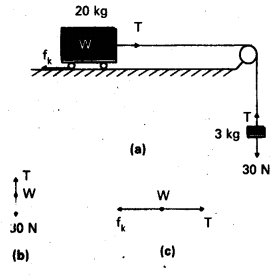
Answer:
As the string is inextensible, and the pully is smooth, the 3 kg block and the 20 kg trolley both have same magnitude of acceleration. Applying second law to motion of the block (Fig. (b).
30 – T = 3a
Apply the second law to motion of the trolley (Fig. (c))
T – fk = 20a
Now fk = μk N,
Here μk = 0.04
N = 20 × 10 = 200N
Thus the equation for the motion of the trolley is
T – 0.04 × 200 = 20 a or T – 8 = 20a
These equations give a = \(\frac{22}{23}\) m s-2 = 0.96 m s-2 and T = 27.1 N.

Question 10.
A cyclist speeding at 18 km/h on a level road takes a sharp circular turn of radius 3 m without reducing the speed. The co-efficient of static friction between the tyres and the road is 0.1. Will the cyclist slip while taking the turn ?
Answer:
On an unbanked road, frictional force alone can provide the centripetal force needed to keep the cyclist moving on a circular turn without slipping. If the speed is too large, or if the turn is too sharp (i.e. of too small a radius) or both, the frictional force is not sufficient to provide the necessary centripetal force, and the cyclist slips. The condition for the cyclist not to slip is given by
vmax = \(\sqrt{\mu_s R_g}\) v2 ≤ μs Rg
Now, R = 3m, g = 9.8 m s-2, μs = 0.1.
That is, μs R g = 2.94 m2 s-2. v = 18 km/h = 5 m s-1; i.e., = 25 v2. The condition is not obeyed. The cyclist will slip while taking the circular turn.
Question 11.
A circular racetrack of radius 300 m is banked at an angle of 15°. If the coefficient of friction between the wheels of a race-car and the road is 0.2, what is the(a) optimum speed of the race-car to avoid wear and tear on its tyres, and (b) maximum permissible speed to avoid slipping?
Answer:
On a banked road, the horizontal component of the normal force and the frictional force contribute to provide centripetal force to keep the car moving on a circular turn without slipping. At the optimum speed, the normal reaction’s component is enough to provide the needed centripetal force, and the frictional force is not needed. The optimum speed v0 is given by
v0 = (R g tan θ)1/2–
Here R = 300 m, θ = 15°, g = 9.8 m s-2; we have
v0 = 28.1 ms-1
The maximum permissible speed vmax is given by
vmax = R g\(\left(\frac{\mu_s+\tan \theta}{1-\mu_s \tan \theta}\right)^{1 / 2}\) = 38.1 m s-1

Question 12.
See (Fig.) A wooden block of mass 2 kg rests on a soft horizontal floor. When an iron cylinder of mass 25 kg is placed on top of the block, the floor yields steadily and the block and the cylinder together go down with an acceleration of 0.1 ms-2. What is the action of the block on the floor (a) before and (b) after the floor yields ? Take g = 10 m s-2. Identify the action- reaction pairs in the problem.
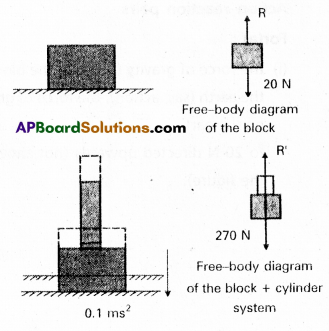
Answer:
(a) The block is at rest on the floor. Its free- body diagram shows two forces on the block, the force of gravitational attraction by the earth equal to 2 × 10 = 20 N; and the normal force R of the floor on the block. By the First Law, the net force on the block must be zero i.e., R = 20 N. Using third law the action of the block (i.e. the force exerted on the floor by the block) is equal to 20 N and directed vertically downwards.
(b)The system (block cylinder) accelerates downwards with 0.1 ms-2. The free – body diagram of the system shows two forces on the system : the force of gravity due to the earth (270 N); and the normal force R’ by the floor. Note, the free-body diagram of the system does not show the internal forces between the block and the cylinder. Applying the second law to the system,
270 – R’ = 27 × 0.1 N
i.e, R’ = 267.3 N
By the third law, the action of the system on the floor is equal to 267.3 N vertically downward.
Action-reaction pairs
For (a) :
(i) the force of gravity (20N) on the block by the earth (say, action); the force of gravity on the earth by the block (reaction) equal to 20 N directed upwards (not shown in the figure).
(ii) the force on the floor by the block (action); the force on the block by the floor (reaction).
For (b):
(i) the force of gravity (270 N) on the system by the earth (say, action), the force of gravity on the earth by the system (reaction), equal to 270 N, directed upwards (not shown in the figure).
(ii) the force on the floor by the system (action); the force on the system by the floor (reaction). In addition, for (b), the force on the block by the cylinder and the force on the cylinder by the block also constitute an action-reaction pair.
The important thing to remember is that an action-reaction pair consists of mutual fortes which are always equal and opposite between two bodies. Two forces on the same body which happen to be. equal and opposite can never constitute an action-reaction pair. The force of gravity on the mass in (a) or (b) and the normal force on the mass by the floor are not action-reaction pairs. These forces happen to be equal and opposite for (a) since the mass is at rest. They are not so for case (b), as seen already. The weight of the system is 270 N, while the normal force R’ is 267.3 N.
![]()


![]()
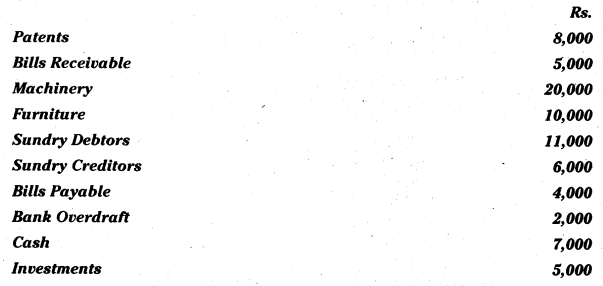
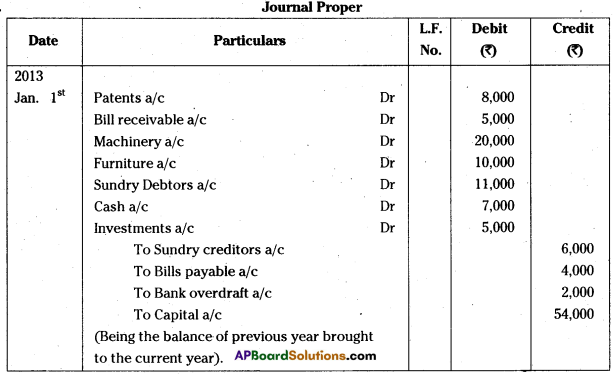
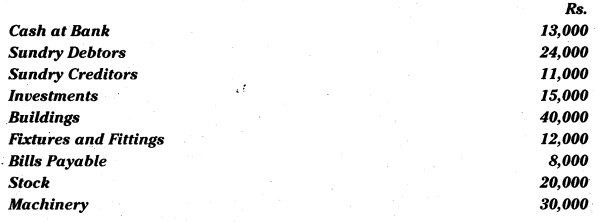
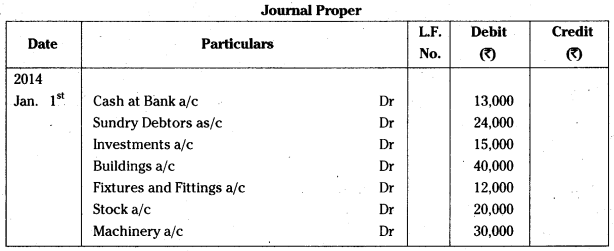


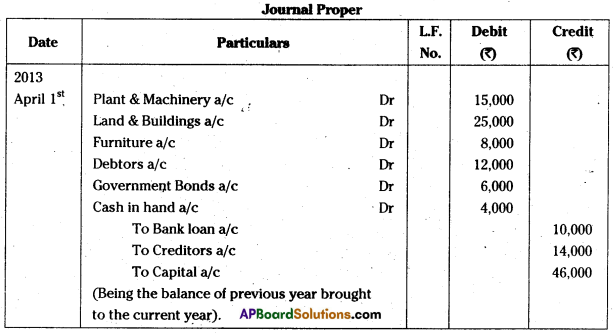
![]()






![]()
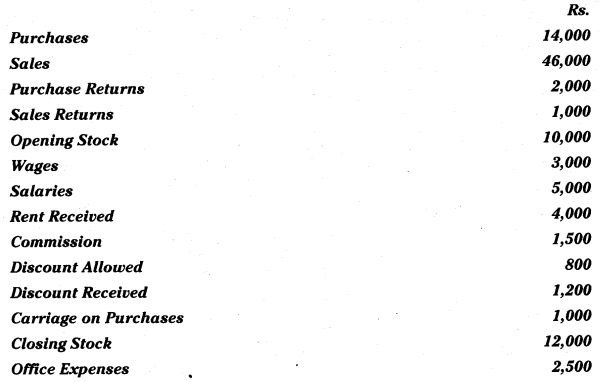
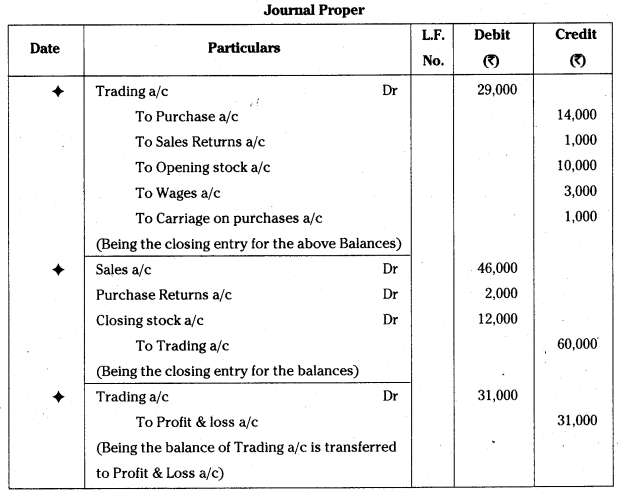
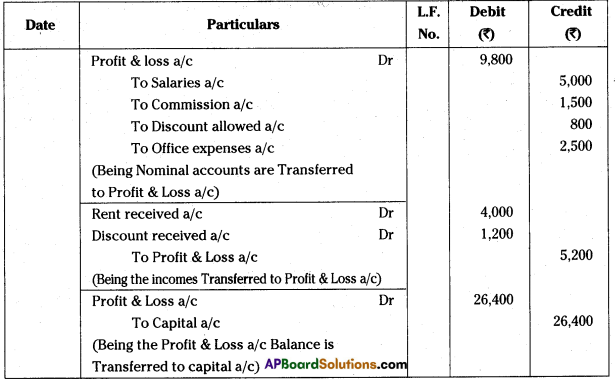


![]()
